UK Government Initiatives and HRD
VerifiedAdded on 2020/06/05
|20
|5730
|229
AI Summary
The assignment explores how UK government-funded training programs like 'Train to Gain' influence employee performance and organizational success. It emphasizes the importance of adopting these initiatives for achieving company goals and maintaining a competitive edge in the market.
Contribute Materials
Your contribution can guide someone’s learning journey. Share your
documents today.
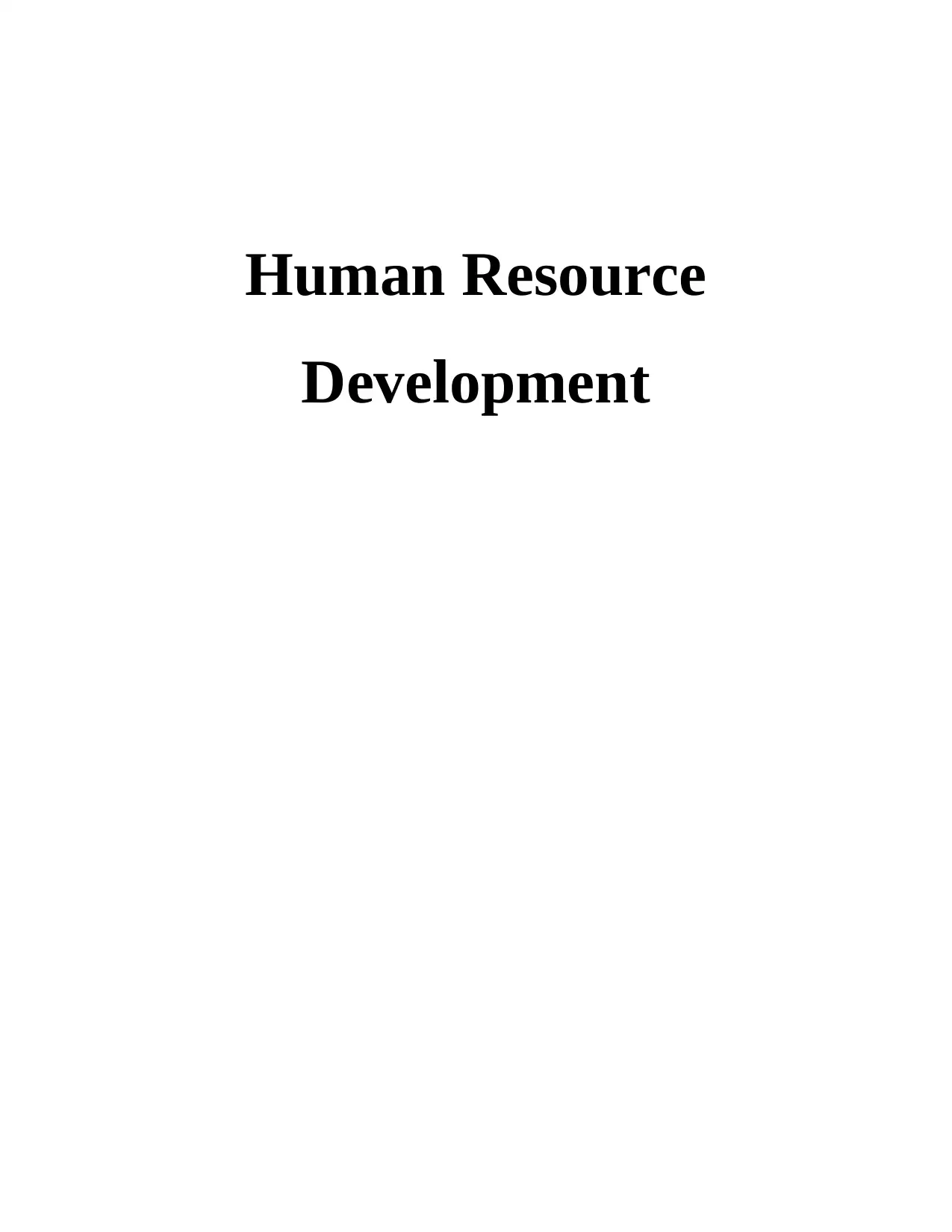
Human Resource
Development
Development
Secure Best Marks with AI Grader
Need help grading? Try our AI Grader for instant feedback on your assignments.
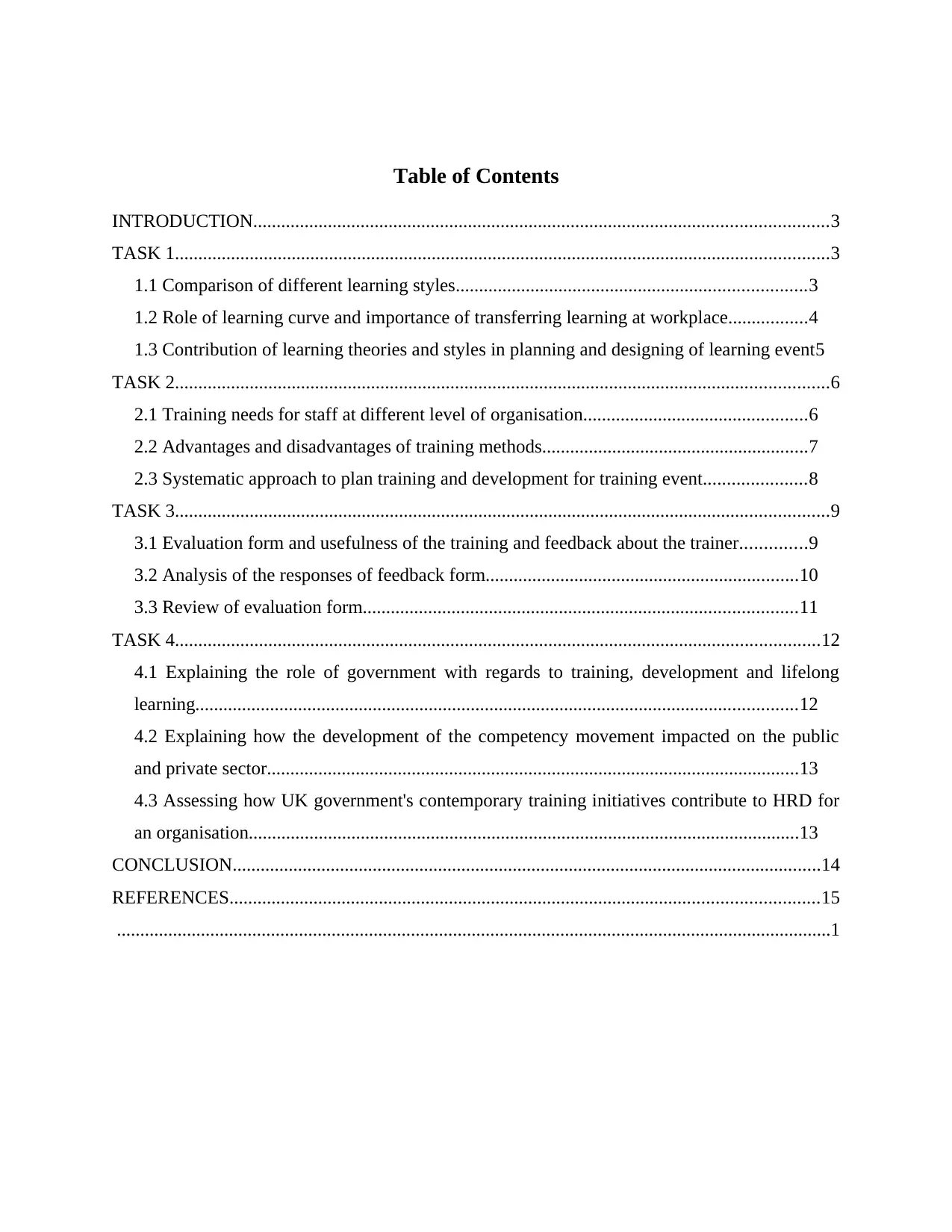
Table of Contents
INTRODUCTION...........................................................................................................................3
TASK 1............................................................................................................................................3
1.1 Comparison of different learning styles...........................................................................3
1.2 Role of learning curve and importance of transferring learning at workplace.................4
1.3 Contribution of learning theories and styles in planning and designing of learning event5
TASK 2............................................................................................................................................6
2.1 Training needs for staff at different level of organisation................................................6
2.2 Advantages and disadvantages of training methods.........................................................7
2.3 Systematic approach to plan training and development for training event......................8
TASK 3............................................................................................................................................9
3.1 Evaluation form and usefulness of the training and feedback about the trainer..............9
3.2 Analysis of the responses of feedback form...................................................................10
3.3 Review of evaluation form.............................................................................................11
TASK 4..........................................................................................................................................12
4.1 Explaining the role of government with regards to training, development and lifelong
learning.................................................................................................................................12
4.2 Explaining how the development of the competency movement impacted on the public
and private sector..................................................................................................................13
4.3 Assessing how UK government's contemporary training initiatives contribute to HRD for
an organisation......................................................................................................................13
CONCLUSION..............................................................................................................................14
REFERENCES..............................................................................................................................15
.........................................................................................................................................................1
INTRODUCTION...........................................................................................................................3
TASK 1............................................................................................................................................3
1.1 Comparison of different learning styles...........................................................................3
1.2 Role of learning curve and importance of transferring learning at workplace.................4
1.3 Contribution of learning theories and styles in planning and designing of learning event5
TASK 2............................................................................................................................................6
2.1 Training needs for staff at different level of organisation................................................6
2.2 Advantages and disadvantages of training methods.........................................................7
2.3 Systematic approach to plan training and development for training event......................8
TASK 3............................................................................................................................................9
3.1 Evaluation form and usefulness of the training and feedback about the trainer..............9
3.2 Analysis of the responses of feedback form...................................................................10
3.3 Review of evaluation form.............................................................................................11
TASK 4..........................................................................................................................................12
4.1 Explaining the role of government with regards to training, development and lifelong
learning.................................................................................................................................12
4.2 Explaining how the development of the competency movement impacted on the public
and private sector..................................................................................................................13
4.3 Assessing how UK government's contemporary training initiatives contribute to HRD for
an organisation......................................................................................................................13
CONCLUSION..............................................................................................................................14
REFERENCES..............................................................................................................................15
.........................................................................................................................................................1
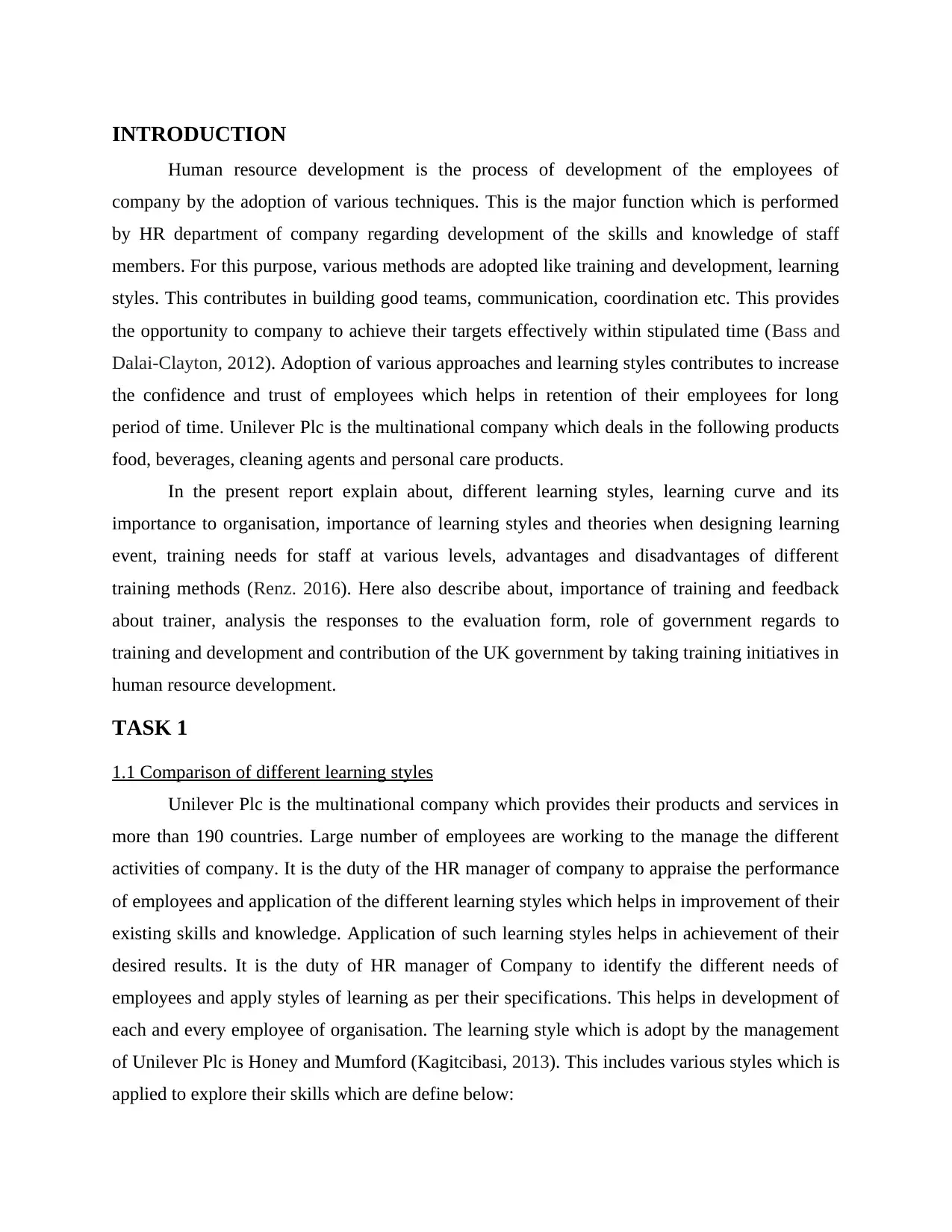
INTRODUCTION
Human resource development is the process of development of the employees of
company by the adoption of various techniques. This is the major function which is performed
by HR department of company regarding development of the skills and knowledge of staff
members. For this purpose, various methods are adopted like training and development, learning
styles. This contributes in building good teams, communication, coordination etc. This provides
the opportunity to company to achieve their targets effectively within stipulated time (Bass and
Dalai-Clayton, 2012). Adoption of various approaches and learning styles contributes to increase
the confidence and trust of employees which helps in retention of their employees for long
period of time. Unilever Plc is the multinational company which deals in the following products
food, beverages, cleaning agents and personal care products.
In the present report explain about, different learning styles, learning curve and its
importance to organisation, importance of learning styles and theories when designing learning
event, training needs for staff at various levels, advantages and disadvantages of different
training methods (Renz. 2016). Here also describe about, importance of training and feedback
about trainer, analysis the responses to the evaluation form, role of government regards to
training and development and contribution of the UK government by taking training initiatives in
human resource development.
TASK 1
1.1 Comparison of different learning styles
Unilever Plc is the multinational company which provides their products and services in
more than 190 countries. Large number of employees are working to the manage the different
activities of company. It is the duty of the HR manager of company to appraise the performance
of employees and application of the different learning styles which helps in improvement of their
existing skills and knowledge. Application of such learning styles helps in achievement of their
desired results. It is the duty of HR manager of Company to identify the different needs of
employees and apply styles of learning as per their specifications. This helps in development of
each and every employee of organisation. The learning style which is adopt by the management
of Unilever Plc is Honey and Mumford (Kagitcibasi, 2013). This includes various styles which is
applied to explore their skills which are define below:
Human resource development is the process of development of the employees of
company by the adoption of various techniques. This is the major function which is performed
by HR department of company regarding development of the skills and knowledge of staff
members. For this purpose, various methods are adopted like training and development, learning
styles. This contributes in building good teams, communication, coordination etc. This provides
the opportunity to company to achieve their targets effectively within stipulated time (Bass and
Dalai-Clayton, 2012). Adoption of various approaches and learning styles contributes to increase
the confidence and trust of employees which helps in retention of their employees for long
period of time. Unilever Plc is the multinational company which deals in the following products
food, beverages, cleaning agents and personal care products.
In the present report explain about, different learning styles, learning curve and its
importance to organisation, importance of learning styles and theories when designing learning
event, training needs for staff at various levels, advantages and disadvantages of different
training methods (Renz. 2016). Here also describe about, importance of training and feedback
about trainer, analysis the responses to the evaluation form, role of government regards to
training and development and contribution of the UK government by taking training initiatives in
human resource development.
TASK 1
1.1 Comparison of different learning styles
Unilever Plc is the multinational company which provides their products and services in
more than 190 countries. Large number of employees are working to the manage the different
activities of company. It is the duty of the HR manager of company to appraise the performance
of employees and application of the different learning styles which helps in improvement of their
existing skills and knowledge. Application of such learning styles helps in achievement of their
desired results. It is the duty of HR manager of Company to identify the different needs of
employees and apply styles of learning as per their specifications. This helps in development of
each and every employee of organisation. The learning style which is adopt by the management
of Unilever Plc is Honey and Mumford (Kagitcibasi, 2013). This includes various styles which is
applied to explore their skills which are define below:

Activist: This learning style is adopt for such employees of company which are learn by
doing the work in organisation. This style is applied on the case of such employees which
are open minded and like to have group discussions and problem solving sessions. This
helps in gaining the experience of the work in real situations.
Theorist: This style is adopt for such kind of learners which are like to follow models
and reading of the facts to improve their knowledge and performances. These learners are
love to read stories and quotes and wants to gain the background information as much
they can.
Pragmatist: This style is used on such learners which like to apply their learning on the
real situation. They wants to do experiment with theories,, methods and techniques to
accomplish their targets.
Reflector: This includes the such persons which are learn by watching other individuals.
This style of learning apply on such employees which gains the knowledge by observing
other employees and collect information from their and works towards the achievement
of appropriate conclusion (Hakansson, 2015).
VARK learning style
VARK is an importance to outsource a learning styles inventory . They were having a
four perceptual : visual, aural, read, kinesthetic . Its designed to be a conversation of teachers and
learners about learning. This strategy were divided into different categories such like as
teaching,variety of learning etc. Sometimes a learner are knowing how to learn and they need no
help from any inventory. Therefore , a modal term was not fixed but they are stable as always .
Both teachers and students are reliable to identifying the preferences in learning. Their
information which were assessed using a strategies and motivating also.
1.2 Role of learning curve and importance of transferring learning at workplace
Learning curve: This curve reflects the ability of employees to accomplish their
objectives during the process of gaining skills and development of personality. This curve
provides the opportunity to the management of company to understand the relationship between
learning and experience which gained through development of skills and knowledge. This shows
that after getting experience, time required to complete their tasks is reduced. Now, it is the duty
of the HR manager of company to identify the different learning of their employees and provide
doing the work in organisation. This style is applied on the case of such employees which
are open minded and like to have group discussions and problem solving sessions. This
helps in gaining the experience of the work in real situations.
Theorist: This style is adopt for such kind of learners which are like to follow models
and reading of the facts to improve their knowledge and performances. These learners are
love to read stories and quotes and wants to gain the background information as much
they can.
Pragmatist: This style is used on such learners which like to apply their learning on the
real situation. They wants to do experiment with theories,, methods and techniques to
accomplish their targets.
Reflector: This includes the such persons which are learn by watching other individuals.
This style of learning apply on such employees which gains the knowledge by observing
other employees and collect information from their and works towards the achievement
of appropriate conclusion (Hakansson, 2015).
VARK learning style
VARK is an importance to outsource a learning styles inventory . They were having a
four perceptual : visual, aural, read, kinesthetic . Its designed to be a conversation of teachers and
learners about learning. This strategy were divided into different categories such like as
teaching,variety of learning etc. Sometimes a learner are knowing how to learn and they need no
help from any inventory. Therefore , a modal term was not fixed but they are stable as always .
Both teachers and students are reliable to identifying the preferences in learning. Their
information which were assessed using a strategies and motivating also.
1.2 Role of learning curve and importance of transferring learning at workplace
Learning curve: This curve reflects the ability of employees to accomplish their
objectives during the process of gaining skills and development of personality. This curve
provides the opportunity to the management of company to understand the relationship between
learning and experience which gained through development of skills and knowledge. This shows
that after getting experience, time required to complete their tasks is reduced. Now, it is the duty
of the HR manager of company to identify the different learning of their employees and provide
Secure Best Marks with AI Grader
Need help grading? Try our AI Grader for instant feedback on your assignments.
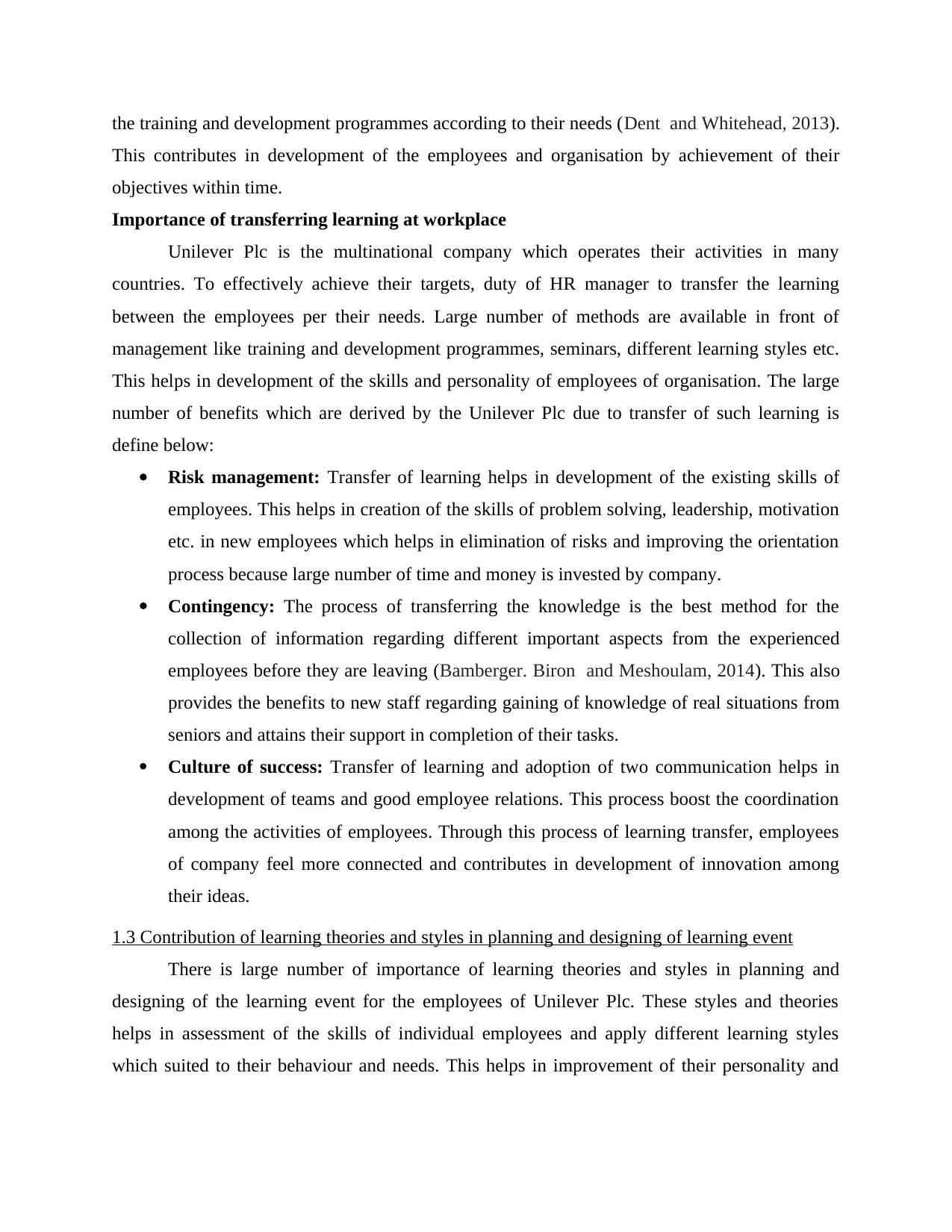
the training and development programmes according to their needs (Dent and Whitehead, 2013).
This contributes in development of the employees and organisation by achievement of their
objectives within time.
Importance of transferring learning at workplace
Unilever Plc is the multinational company which operates their activities in many
countries. To effectively achieve their targets, duty of HR manager to transfer the learning
between the employees per their needs. Large number of methods are available in front of
management like training and development programmes, seminars, different learning styles etc.
This helps in development of the skills and personality of employees of organisation. The large
number of benefits which are derived by the Unilever Plc due to transfer of such learning is
define below:
Risk management: Transfer of learning helps in development of the existing skills of
employees. This helps in creation of the skills of problem solving, leadership, motivation
etc. in new employees which helps in elimination of risks and improving the orientation
process because large number of time and money is invested by company.
Contingency: The process of transferring the knowledge is the best method for the
collection of information regarding different important aspects from the experienced
employees before they are leaving (Bamberger. Biron and Meshoulam, 2014). This also
provides the benefits to new staff regarding gaining of knowledge of real situations from
seniors and attains their support in completion of their tasks.
Culture of success: Transfer of learning and adoption of two communication helps in
development of teams and good employee relations. This process boost the coordination
among the activities of employees. Through this process of learning transfer, employees
of company feel more connected and contributes in development of innovation among
their ideas.
1.3 Contribution of learning theories and styles in planning and designing of learning event
There is large number of importance of learning theories and styles in planning and
designing of the learning event for the employees of Unilever Plc. These styles and theories
helps in assessment of the skills of individual employees and apply different learning styles
which suited to their behaviour and needs. This helps in improvement of their personality and
This contributes in development of the employees and organisation by achievement of their
objectives within time.
Importance of transferring learning at workplace
Unilever Plc is the multinational company which operates their activities in many
countries. To effectively achieve their targets, duty of HR manager to transfer the learning
between the employees per their needs. Large number of methods are available in front of
management like training and development programmes, seminars, different learning styles etc.
This helps in development of the skills and personality of employees of organisation. The large
number of benefits which are derived by the Unilever Plc due to transfer of such learning is
define below:
Risk management: Transfer of learning helps in development of the existing skills of
employees. This helps in creation of the skills of problem solving, leadership, motivation
etc. in new employees which helps in elimination of risks and improving the orientation
process because large number of time and money is invested by company.
Contingency: The process of transferring the knowledge is the best method for the
collection of information regarding different important aspects from the experienced
employees before they are leaving (Bamberger. Biron and Meshoulam, 2014). This also
provides the benefits to new staff regarding gaining of knowledge of real situations from
seniors and attains their support in completion of their tasks.
Culture of success: Transfer of learning and adoption of two communication helps in
development of teams and good employee relations. This process boost the coordination
among the activities of employees. Through this process of learning transfer, employees
of company feel more connected and contributes in development of innovation among
their ideas.
1.3 Contribution of learning theories and styles in planning and designing of learning event
There is large number of importance of learning theories and styles in planning and
designing of the learning event for the employees of Unilever Plc. These styles and theories
helps in assessment of the skills of individual employees and apply different learning styles
which suited to their behaviour and needs. This helps in improvement of their personality and
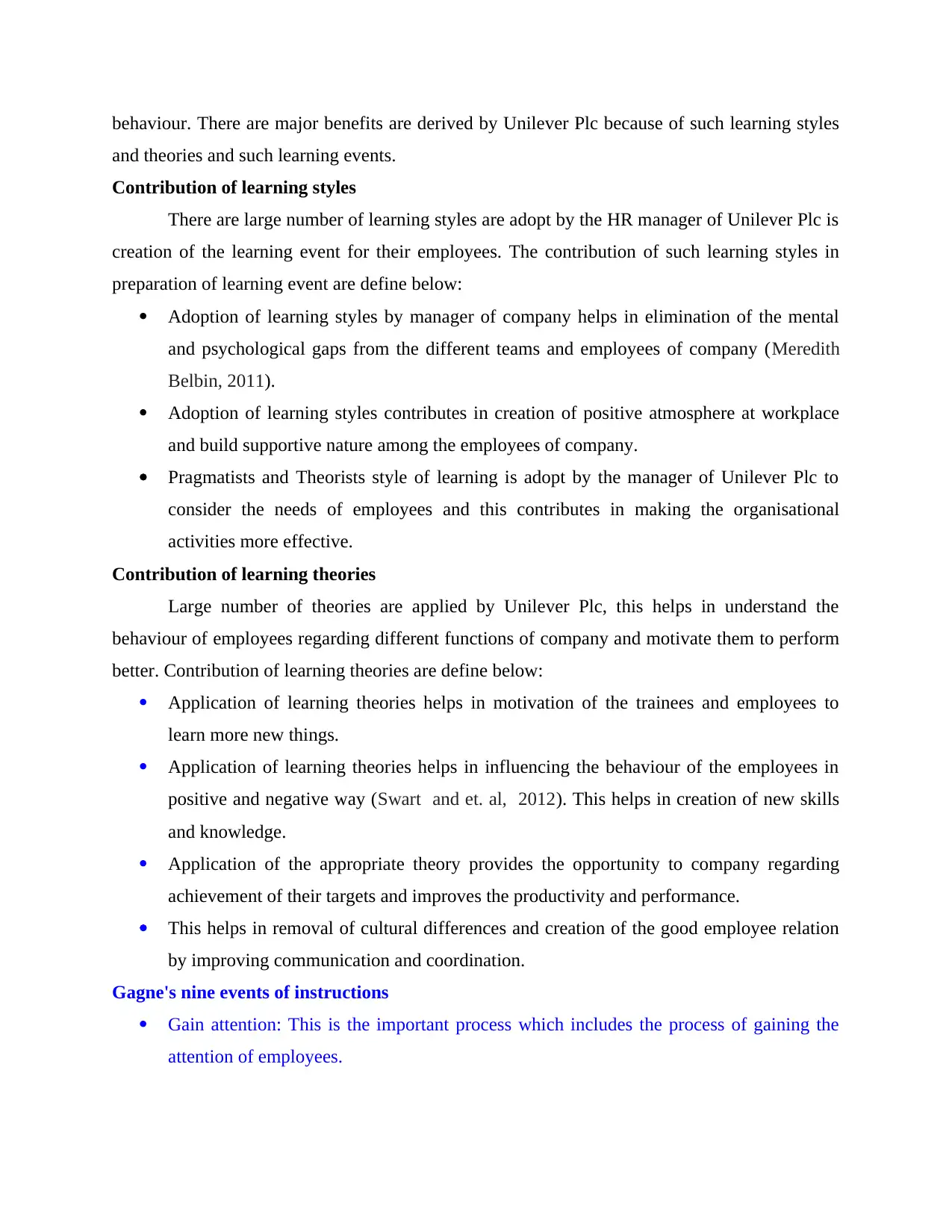
behaviour. There are major benefits are derived by Unilever Plc because of such learning styles
and theories and such learning events.
Contribution of learning styles
There are large number of learning styles are adopt by the HR manager of Unilever Plc is
creation of the learning event for their employees. The contribution of such learning styles in
preparation of learning event are define below:
Adoption of learning styles by manager of company helps in elimination of the mental
and psychological gaps from the different teams and employees of company (Meredith
Belbin, 2011).
Adoption of learning styles contributes in creation of positive atmosphere at workplace
and build supportive nature among the employees of company.
Pragmatists and Theorists style of learning is adopt by the manager of Unilever Plc to
consider the needs of employees and this contributes in making the organisational
activities more effective.
Contribution of learning theories
Large number of theories are applied by Unilever Plc, this helps in understand the
behaviour of employees regarding different functions of company and motivate them to perform
better. Contribution of learning theories are define below:
Application of learning theories helps in motivation of the trainees and employees to
learn more new things.
Application of learning theories helps in influencing the behaviour of the employees in
positive and negative way (Swart and et. al, 2012). This helps in creation of new skills
and knowledge.
Application of the appropriate theory provides the opportunity to company regarding
achievement of their targets and improves the productivity and performance.
This helps in removal of cultural differences and creation of the good employee relation
by improving communication and coordination.
Gagne's nine events of instructions
Gain attention: This is the important process which includes the process of gaining the
attention of employees.
and theories and such learning events.
Contribution of learning styles
There are large number of learning styles are adopt by the HR manager of Unilever Plc is
creation of the learning event for their employees. The contribution of such learning styles in
preparation of learning event are define below:
Adoption of learning styles by manager of company helps in elimination of the mental
and psychological gaps from the different teams and employees of company (Meredith
Belbin, 2011).
Adoption of learning styles contributes in creation of positive atmosphere at workplace
and build supportive nature among the employees of company.
Pragmatists and Theorists style of learning is adopt by the manager of Unilever Plc to
consider the needs of employees and this contributes in making the organisational
activities more effective.
Contribution of learning theories
Large number of theories are applied by Unilever Plc, this helps in understand the
behaviour of employees regarding different functions of company and motivate them to perform
better. Contribution of learning theories are define below:
Application of learning theories helps in motivation of the trainees and employees to
learn more new things.
Application of learning theories helps in influencing the behaviour of the employees in
positive and negative way (Swart and et. al, 2012). This helps in creation of new skills
and knowledge.
Application of the appropriate theory provides the opportunity to company regarding
achievement of their targets and improves the productivity and performance.
This helps in removal of cultural differences and creation of the good employee relation
by improving communication and coordination.
Gagne's nine events of instructions
Gain attention: This is the important process which includes the process of gaining the
attention of employees.
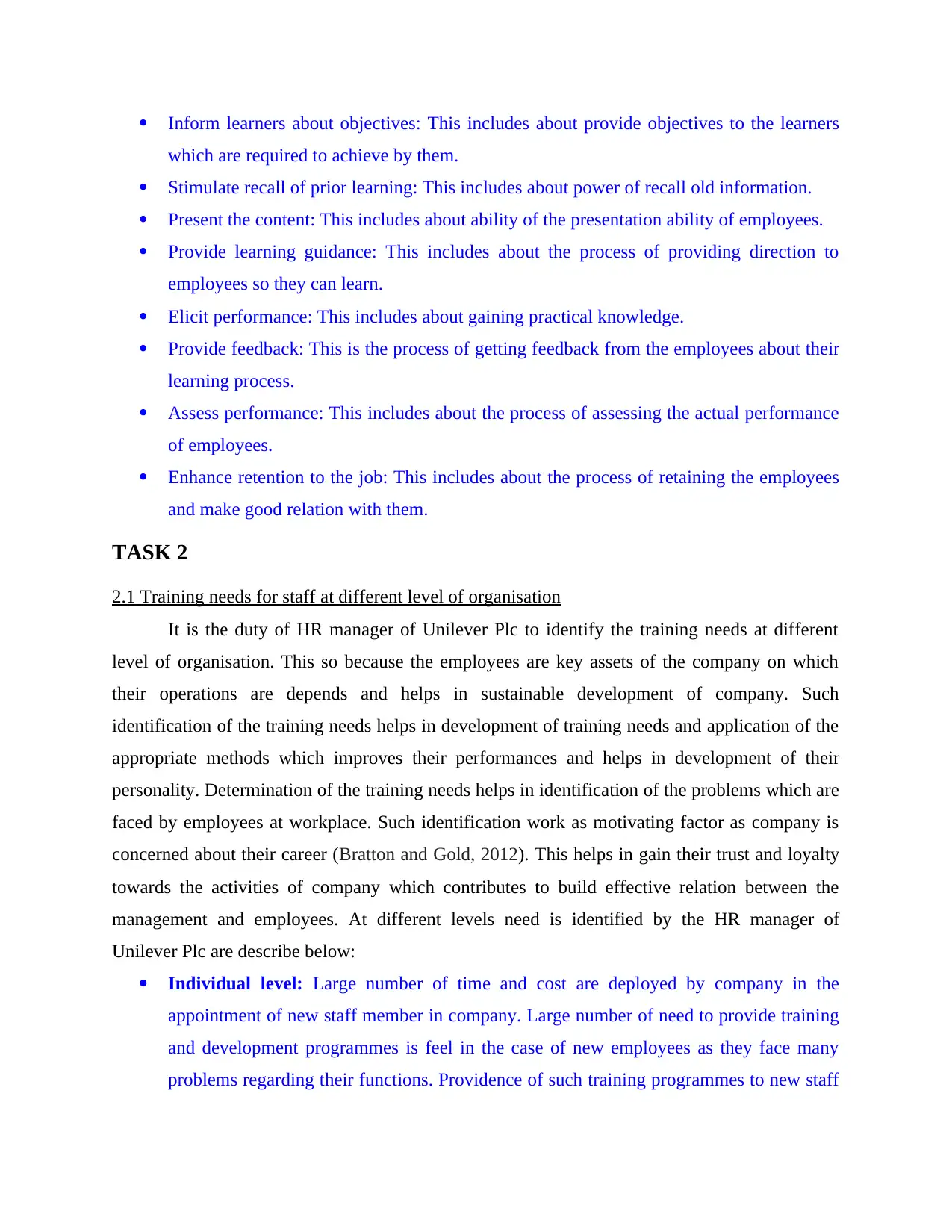
Inform learners about objectives: This includes about provide objectives to the learners
which are required to achieve by them.
Stimulate recall of prior learning: This includes about power of recall old information.
Present the content: This includes about ability of the presentation ability of employees.
Provide learning guidance: This includes about the process of providing direction to
employees so they can learn.
Elicit performance: This includes about gaining practical knowledge.
Provide feedback: This is the process of getting feedback from the employees about their
learning process.
Assess performance: This includes about the process of assessing the actual performance
of employees.
Enhance retention to the job: This includes about the process of retaining the employees
and make good relation with them.
TASK 2
2.1 Training needs for staff at different level of organisation
It is the duty of HR manager of Unilever Plc to identify the training needs at different
level of organisation. This so because the employees are key assets of the company on which
their operations are depends and helps in sustainable development of company. Such
identification of the training needs helps in development of training needs and application of the
appropriate methods which improves their performances and helps in development of their
personality. Determination of the training needs helps in identification of the problems which are
faced by employees at workplace. Such identification work as motivating factor as company is
concerned about their career (Bratton and Gold, 2012). This helps in gain their trust and loyalty
towards the activities of company which contributes to build effective relation between the
management and employees. At different levels need is identified by the HR manager of
Unilever Plc are describe below:
Individual level: Large number of time and cost are deployed by company in the
appointment of new staff member in company. Large number of need to provide training
and development programmes is feel in the case of new employees as they face many
problems regarding their functions. Providence of such training programmes to new staff
which are required to achieve by them.
Stimulate recall of prior learning: This includes about power of recall old information.
Present the content: This includes about ability of the presentation ability of employees.
Provide learning guidance: This includes about the process of providing direction to
employees so they can learn.
Elicit performance: This includes about gaining practical knowledge.
Provide feedback: This is the process of getting feedback from the employees about their
learning process.
Assess performance: This includes about the process of assessing the actual performance
of employees.
Enhance retention to the job: This includes about the process of retaining the employees
and make good relation with them.
TASK 2
2.1 Training needs for staff at different level of organisation
It is the duty of HR manager of Unilever Plc to identify the training needs at different
level of organisation. This so because the employees are key assets of the company on which
their operations are depends and helps in sustainable development of company. Such
identification of the training needs helps in development of training needs and application of the
appropriate methods which improves their performances and helps in development of their
personality. Determination of the training needs helps in identification of the problems which are
faced by employees at workplace. Such identification work as motivating factor as company is
concerned about their career (Bratton and Gold, 2012). This helps in gain their trust and loyalty
towards the activities of company which contributes to build effective relation between the
management and employees. At different levels need is identified by the HR manager of
Unilever Plc are describe below:
Individual level: Large number of time and cost are deployed by company in the
appointment of new staff member in company. Large number of need to provide training
and development programmes is feel in the case of new employees as they face many
problems regarding their functions. Providence of such training programmes to new staff
Paraphrase This Document
Need a fresh take? Get an instant paraphrase of this document with our AI Paraphraser
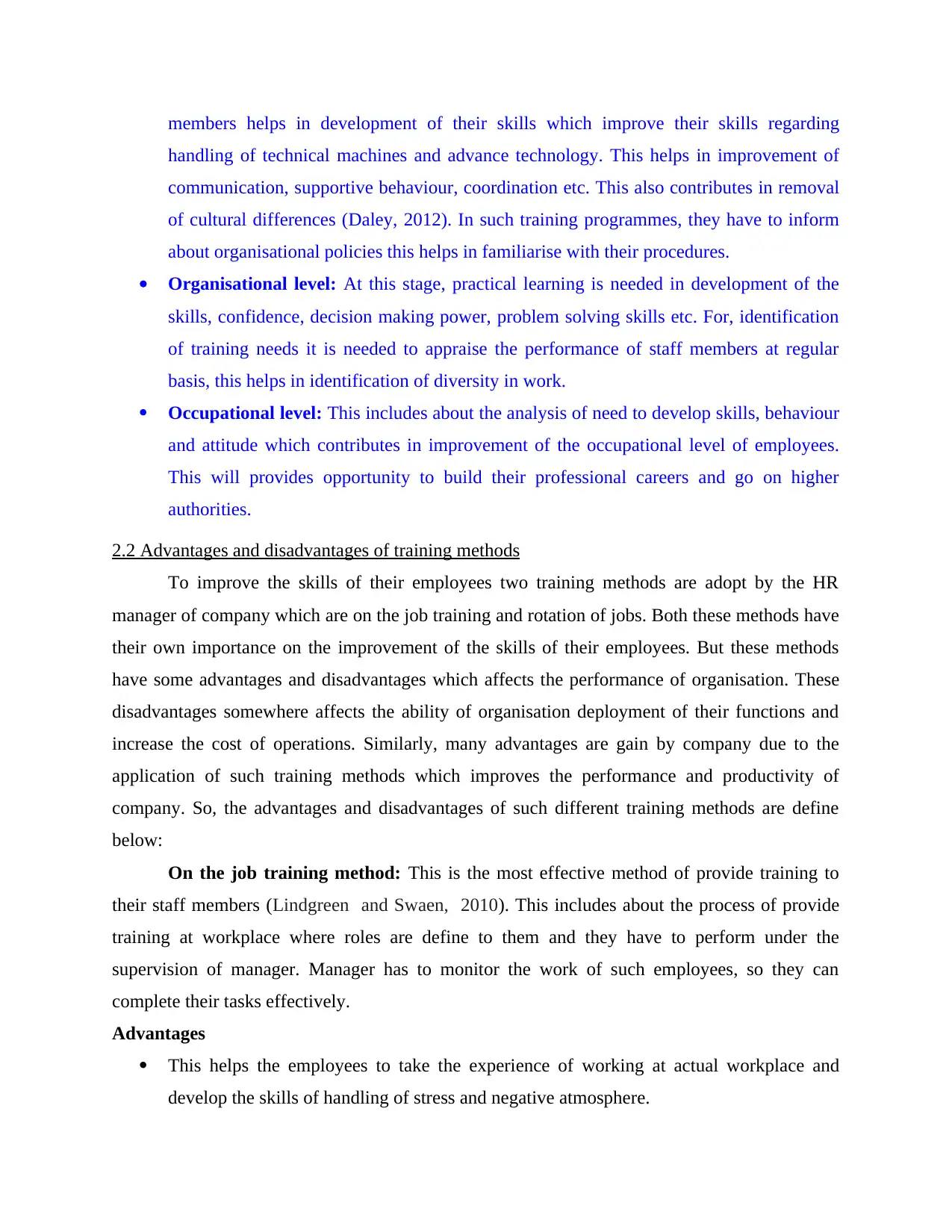
members helps in development of their skills which improve their skills regarding
handling of technical machines and advance technology. This helps in improvement of
communication, supportive behaviour, coordination etc. This also contributes in removal
of cultural differences (Daley, 2012). In such training programmes, they have to inform
about organisational policies this helps in familiarise with their procedures.
Organisational level: At this stage, practical learning is needed in development of the
skills, confidence, decision making power, problem solving skills etc. For, identification
of training needs it is needed to appraise the performance of staff members at regular
basis, this helps in identification of diversity in work.
Occupational level: This includes about the analysis of need to develop skills, behaviour
and attitude which contributes in improvement of the occupational level of employees.
This will provides opportunity to build their professional careers and go on higher
authorities.
2.2 Advantages and disadvantages of training methods
To improve the skills of their employees two training methods are adopt by the HR
manager of company which are on the job training and rotation of jobs. Both these methods have
their own importance on the improvement of the skills of their employees. But these methods
have some advantages and disadvantages which affects the performance of organisation. These
disadvantages somewhere affects the ability of organisation deployment of their functions and
increase the cost of operations. Similarly, many advantages are gain by company due to the
application of such training methods which improves the performance and productivity of
company. So, the advantages and disadvantages of such different training methods are define
below:
On the job training method: This is the most effective method of provide training to
their staff members (Lindgreen and Swaen, 2010). This includes about the process of provide
training at workplace where roles are define to them and they have to perform under the
supervision of manager. Manager has to monitor the work of such employees, so they can
complete their tasks effectively.
Advantages
This helps the employees to take the experience of working at actual workplace and
develop the skills of handling of stress and negative atmosphere.
handling of technical machines and advance technology. This helps in improvement of
communication, supportive behaviour, coordination etc. This also contributes in removal
of cultural differences (Daley, 2012). In such training programmes, they have to inform
about organisational policies this helps in familiarise with their procedures.
Organisational level: At this stage, practical learning is needed in development of the
skills, confidence, decision making power, problem solving skills etc. For, identification
of training needs it is needed to appraise the performance of staff members at regular
basis, this helps in identification of diversity in work.
Occupational level: This includes about the analysis of need to develop skills, behaviour
and attitude which contributes in improvement of the occupational level of employees.
This will provides opportunity to build their professional careers and go on higher
authorities.
2.2 Advantages and disadvantages of training methods
To improve the skills of their employees two training methods are adopt by the HR
manager of company which are on the job training and rotation of jobs. Both these methods have
their own importance on the improvement of the skills of their employees. But these methods
have some advantages and disadvantages which affects the performance of organisation. These
disadvantages somewhere affects the ability of organisation deployment of their functions and
increase the cost of operations. Similarly, many advantages are gain by company due to the
application of such training methods which improves the performance and productivity of
company. So, the advantages and disadvantages of such different training methods are define
below:
On the job training method: This is the most effective method of provide training to
their staff members (Lindgreen and Swaen, 2010). This includes about the process of provide
training at workplace where roles are define to them and they have to perform under the
supervision of manager. Manager has to monitor the work of such employees, so they can
complete their tasks effectively.
Advantages
This helps the employees to take the experience of working at actual workplace and
develop the skills of handling of stress and negative atmosphere.
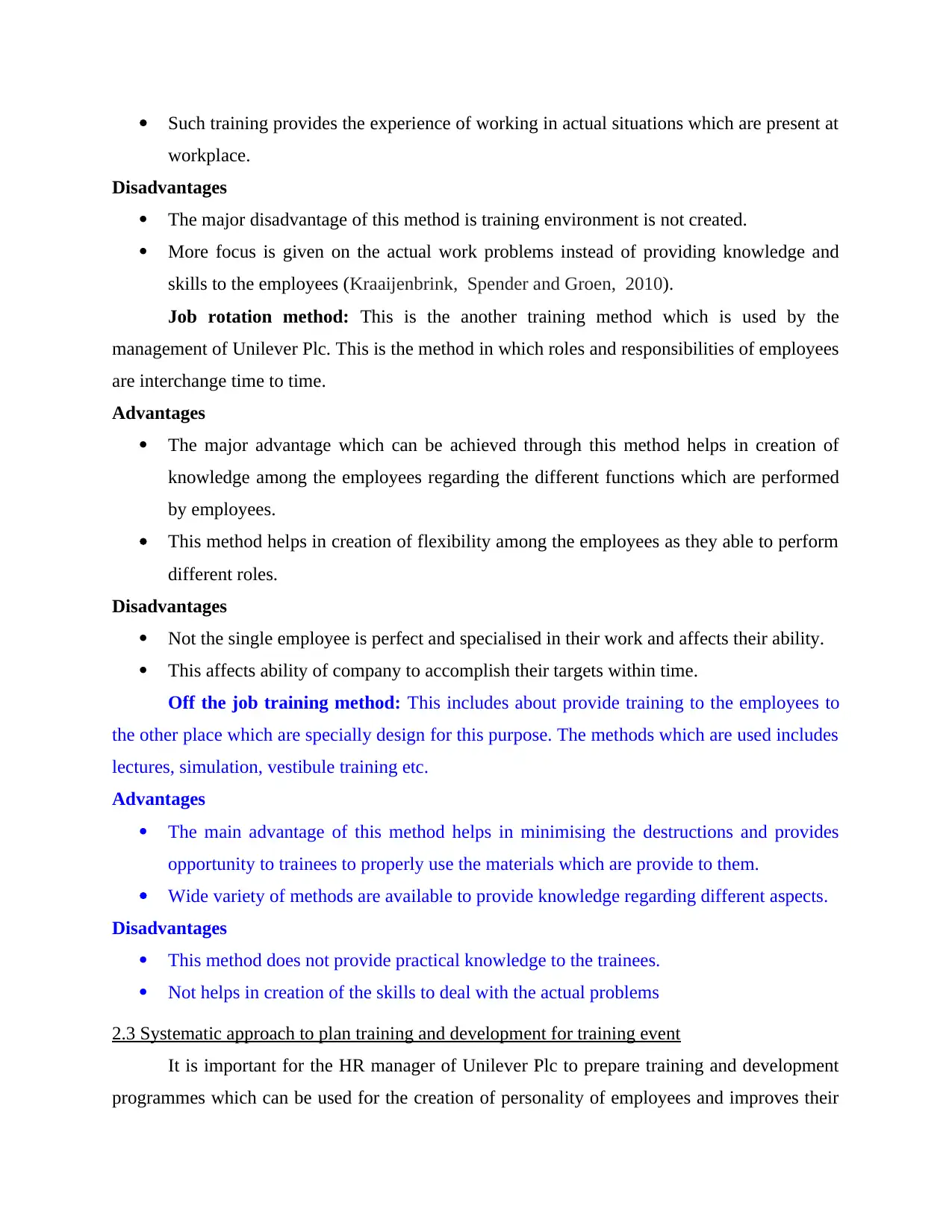
Such training provides the experience of working in actual situations which are present at
workplace.
Disadvantages
The major disadvantage of this method is training environment is not created.
More focus is given on the actual work problems instead of providing knowledge and
skills to the employees (Kraaijenbrink, Spender and Groen, 2010).
Job rotation method: This is the another training method which is used by the
management of Unilever Plc. This is the method in which roles and responsibilities of employees
are interchange time to time.
Advantages
The major advantage which can be achieved through this method helps in creation of
knowledge among the employees regarding the different functions which are performed
by employees.
This method helps in creation of flexibility among the employees as they able to perform
different roles.
Disadvantages
Not the single employee is perfect and specialised in their work and affects their ability.
This affects ability of company to accomplish their targets within time.
Off the job training method: This includes about provide training to the employees to
the other place which are specially design for this purpose. The methods which are used includes
lectures, simulation, vestibule training etc.
Advantages
The main advantage of this method helps in minimising the destructions and provides
opportunity to trainees to properly use the materials which are provide to them.
Wide variety of methods are available to provide knowledge regarding different aspects.
Disadvantages
This method does not provide practical knowledge to the trainees.
Not helps in creation of the skills to deal with the actual problems
2.3 Systematic approach to plan training and development for training event
It is important for the HR manager of Unilever Plc to prepare training and development
programmes which can be used for the creation of personality of employees and improves their
workplace.
Disadvantages
The major disadvantage of this method is training environment is not created.
More focus is given on the actual work problems instead of providing knowledge and
skills to the employees (Kraaijenbrink, Spender and Groen, 2010).
Job rotation method: This is the another training method which is used by the
management of Unilever Plc. This is the method in which roles and responsibilities of employees
are interchange time to time.
Advantages
The major advantage which can be achieved through this method helps in creation of
knowledge among the employees regarding the different functions which are performed
by employees.
This method helps in creation of flexibility among the employees as they able to perform
different roles.
Disadvantages
Not the single employee is perfect and specialised in their work and affects their ability.
This affects ability of company to accomplish their targets within time.
Off the job training method: This includes about provide training to the employees to
the other place which are specially design for this purpose. The methods which are used includes
lectures, simulation, vestibule training etc.
Advantages
The main advantage of this method helps in minimising the destructions and provides
opportunity to trainees to properly use the materials which are provide to them.
Wide variety of methods are available to provide knowledge regarding different aspects.
Disadvantages
This method does not provide practical knowledge to the trainees.
Not helps in creation of the skills to deal with the actual problems
2.3 Systematic approach to plan training and development for training event
It is important for the HR manager of Unilever Plc to prepare training and development
programmes which can be used for the creation of personality of employees and improves their

passion towards the functions of company. For the preparation of training programmes systemic
approach is used by the management of company (Surroca, Tribó and Waddock, 2010). This
approach helps in designing of the training which ends with the achievement of needs of
company. Such training programmes includes various training methods and tools as per the
different needs of their employees. The various steps which are include in systematic approach
used by company includes followings points:
Analysis: This is the first step which includes about the identification of the different
training needs as per the different problems faced by employees, their behaviour and their
ability of achievement of organisational objectives.
Design: This is the second step which includes about designing of the different training
methods and tool which helps in the development of the skills and contributes in
achievement of organisational objectives.
Development: This includes about the preparation of different training programmes as
per the problems faced by each and every employee of company. So, it is the process of
developing and adoption of training method.
Implementation: This process includes about the implementation of such methods in
actual. This is the step in which employees are using learning tools in actual for the
development of their skills.
Evaluation: This step is includes about the process of evaluating the affectivity of
training methods which are applied by the company in the development of the skills of
employees (Linnenluecke and Griffiths, 2010). This can be evaluate by the use of
knowledge of employees in actual situations and through their feedbacks.
TASK 3
3.1 Evaluation form and usefulness of the training and feedback about the trainer
There are many training methods are adopt by the management of Unilever Plc for the
development of their employees so they can achieve the organisational targets effectively. For
this purpose, training programmes are conduct to increase the skills of their staff member so
they can easily complete their functions. To know about the effectiveness of such training
programmes and what the staff is learnt can be determined thorough the feedback form. Such
approach is used by the management of company (Surroca, Tribó and Waddock, 2010). This
approach helps in designing of the training which ends with the achievement of needs of
company. Such training programmes includes various training methods and tools as per the
different needs of their employees. The various steps which are include in systematic approach
used by company includes followings points:
Analysis: This is the first step which includes about the identification of the different
training needs as per the different problems faced by employees, their behaviour and their
ability of achievement of organisational objectives.
Design: This is the second step which includes about designing of the different training
methods and tool which helps in the development of the skills and contributes in
achievement of organisational objectives.
Development: This includes about the preparation of different training programmes as
per the problems faced by each and every employee of company. So, it is the process of
developing and adoption of training method.
Implementation: This process includes about the implementation of such methods in
actual. This is the step in which employees are using learning tools in actual for the
development of their skills.
Evaluation: This step is includes about the process of evaluating the affectivity of
training methods which are applied by the company in the development of the skills of
employees (Linnenluecke and Griffiths, 2010). This can be evaluate by the use of
knowledge of employees in actual situations and through their feedbacks.
TASK 3
3.1 Evaluation form and usefulness of the training and feedback about the trainer
There are many training methods are adopt by the management of Unilever Plc for the
development of their employees so they can achieve the organisational targets effectively. For
this purpose, training programmes are conduct to increase the skills of their staff member so
they can easily complete their functions. To know about the effectiveness of such training
programmes and what the staff is learnt can be determined thorough the feedback form. Such
Secure Best Marks with AI Grader
Need help grading? Try our AI Grader for instant feedback on your assignments.
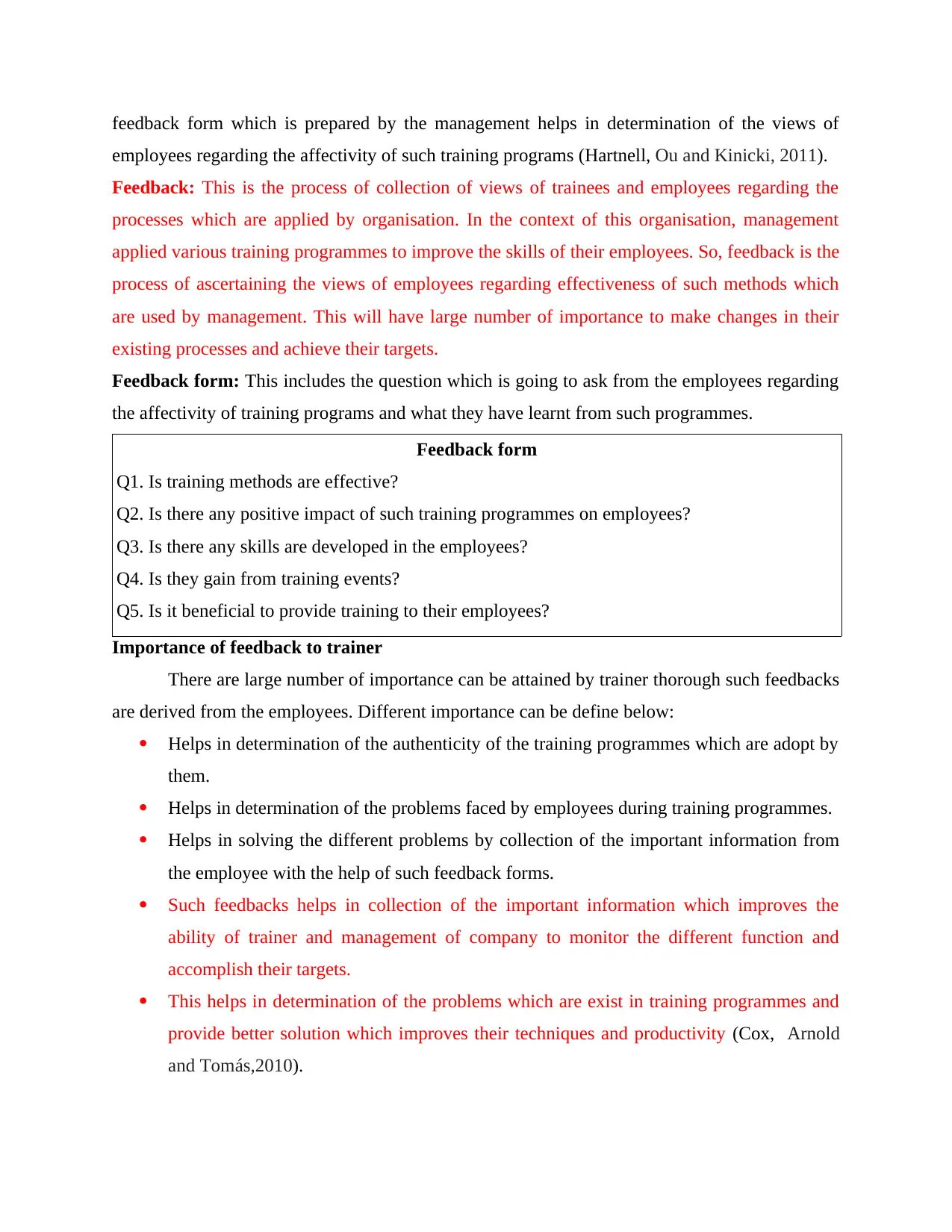
feedback form which is prepared by the management helps in determination of the views of
employees regarding the affectivity of such training programs (Hartnell, Ou and Kinicki, 2011).
Feedback: This is the process of collection of views of trainees and employees regarding the
processes which are applied by organisation. In the context of this organisation, management
applied various training programmes to improve the skills of their employees. So, feedback is the
process of ascertaining the views of employees regarding effectiveness of such methods which
are used by management. This will have large number of importance to make changes in their
existing processes and achieve their targets.
Feedback form: This includes the question which is going to ask from the employees regarding
the affectivity of training programs and what they have learnt from such programmes.
Feedback form
Q1. Is training methods are effective?
Q2. Is there any positive impact of such training programmes on employees?
Q3. Is there any skills are developed in the employees?
Q4. Is they gain from training events?
Q5. Is it beneficial to provide training to their employees?
Importance of feedback to trainer
There are large number of importance can be attained by trainer thorough such feedbacks
are derived from the employees. Different importance can be define below:
Helps in determination of the authenticity of the training programmes which are adopt by
them.
Helps in determination of the problems faced by employees during training programmes.
Helps in solving the different problems by collection of the important information from
the employee with the help of such feedback forms.
Such feedbacks helps in collection of the important information which improves the
ability of trainer and management of company to monitor the different function and
accomplish their targets.
This helps in determination of the problems which are exist in training programmes and
provide better solution which improves their techniques and productivity (Cox, Arnold
and Tomás,2010).
employees regarding the affectivity of such training programs (Hartnell, Ou and Kinicki, 2011).
Feedback: This is the process of collection of views of trainees and employees regarding the
processes which are applied by organisation. In the context of this organisation, management
applied various training programmes to improve the skills of their employees. So, feedback is the
process of ascertaining the views of employees regarding effectiveness of such methods which
are used by management. This will have large number of importance to make changes in their
existing processes and achieve their targets.
Feedback form: This includes the question which is going to ask from the employees regarding
the affectivity of training programs and what they have learnt from such programmes.
Feedback form
Q1. Is training methods are effective?
Q2. Is there any positive impact of such training programmes on employees?
Q3. Is there any skills are developed in the employees?
Q4. Is they gain from training events?
Q5. Is it beneficial to provide training to their employees?
Importance of feedback to trainer
There are large number of importance can be attained by trainer thorough such feedbacks
are derived from the employees. Different importance can be define below:
Helps in determination of the authenticity of the training programmes which are adopt by
them.
Helps in determination of the problems faced by employees during training programmes.
Helps in solving the different problems by collection of the important information from
the employee with the help of such feedback forms.
Such feedbacks helps in collection of the important information which improves the
ability of trainer and management of company to monitor the different function and
accomplish their targets.
This helps in determination of the problems which are exist in training programmes and
provide better solution which improves their techniques and productivity (Cox, Arnold
and Tomás,2010).
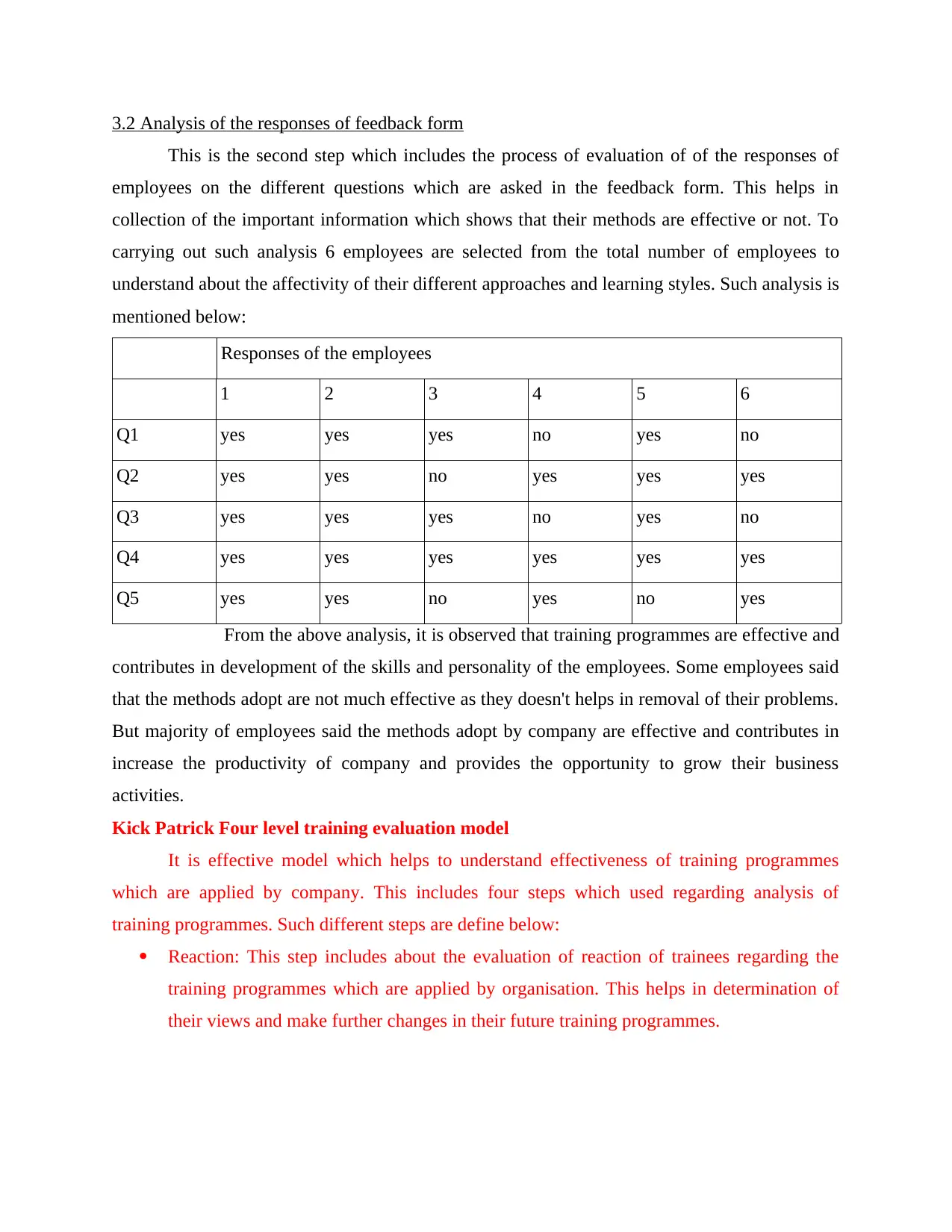
3.2 Analysis of the responses of feedback form
This is the second step which includes the process of evaluation of of the responses of
employees on the different questions which are asked in the feedback form. This helps in
collection of the important information which shows that their methods are effective or not. To
carrying out such analysis 6 employees are selected from the total number of employees to
understand about the affectivity of their different approaches and learning styles. Such analysis is
mentioned below:
Responses of the employees
1 2 3 4 5 6
Q1 yes yes yes no yes no
Q2 yes yes no yes yes yes
Q3 yes yes yes no yes no
Q4 yes yes yes yes yes yes
Q5 yes yes no yes no yes
From the above analysis, it is observed that training programmes are effective and
contributes in development of the skills and personality of the employees. Some employees said
that the methods adopt are not much effective as they doesn't helps in removal of their problems.
But majority of employees said the methods adopt by company are effective and contributes in
increase the productivity of company and provides the opportunity to grow their business
activities.
Kick Patrick Four level training evaluation model
It is effective model which helps to understand effectiveness of training programmes
which are applied by company. This includes four steps which used regarding analysis of
training programmes. Such different steps are define below:
Reaction: This step includes about the evaluation of reaction of trainees regarding the
training programmes which are applied by organisation. This helps in determination of
their views and make further changes in their future training programmes.
This is the second step which includes the process of evaluation of of the responses of
employees on the different questions which are asked in the feedback form. This helps in
collection of the important information which shows that their methods are effective or not. To
carrying out such analysis 6 employees are selected from the total number of employees to
understand about the affectivity of their different approaches and learning styles. Such analysis is
mentioned below:
Responses of the employees
1 2 3 4 5 6
Q1 yes yes yes no yes no
Q2 yes yes no yes yes yes
Q3 yes yes yes no yes no
Q4 yes yes yes yes yes yes
Q5 yes yes no yes no yes
From the above analysis, it is observed that training programmes are effective and
contributes in development of the skills and personality of the employees. Some employees said
that the methods adopt are not much effective as they doesn't helps in removal of their problems.
But majority of employees said the methods adopt by company are effective and contributes in
increase the productivity of company and provides the opportunity to grow their business
activities.
Kick Patrick Four level training evaluation model
It is effective model which helps to understand effectiveness of training programmes
which are applied by company. This includes four steps which used regarding analysis of
training programmes. Such different steps are define below:
Reaction: This step includes about the evaluation of reaction of trainees regarding the
training programmes which are applied by organisation. This helps in determination of
their views and make further changes in their future training programmes.

Learning: This includes about evaluation of learning which is gain by trainees through
their training programmes. This helps in analysis of skills which are added on their
trainees regarding completion of their particular task.
Behaviour: This includes about the identification of change which is perceived by
employees on their behaviour due to such training programmes. This helps to understand
that their training programmes are effective or not or there is some need to make changes.
Results: This is the last step which includes about the determination of the results which
are achieved by trainees after their training programmes. This analysis helps in
identification of that the trainees are skilled to complete their tasks within stipulated time
or not.
3.3 Review of evaluation form
To understand about the affectivity of of their training methods and their contribution in
the development of their existing skills, management used feedback form which comprises
different question regarding training and asked to the employees (Hannah and Avolio, 2010).
Their answer about such different question helps in collection of the information and evaluation
of the training programmes. Many problems are faced regarding communication and supportive
behaviour of employees but after that they are achieved their target. The successfulness of the
feedback form can be understand through the following information which can be derived are
define below:
Training was planned properly: From the feedbacks of employees it is ascertained that
the training program is planned properly as per the needs , behaviour, skills, problems
present at workplace etc. This shows that training events are planned properly.
Training is delivered properly: From the views of employees it is also observed that
training is properly delivered to the employees and their concepts are clear regarding the
use of machines. It is also observed that after training employees are able to achieve their
targets and complete their tasks within time. They also build good teams and creates
positive atmosphere in company.
their training programmes. This helps in analysis of skills which are added on their
trainees regarding completion of their particular task.
Behaviour: This includes about the identification of change which is perceived by
employees on their behaviour due to such training programmes. This helps to understand
that their training programmes are effective or not or there is some need to make changes.
Results: This is the last step which includes about the determination of the results which
are achieved by trainees after their training programmes. This analysis helps in
identification of that the trainees are skilled to complete their tasks within stipulated time
or not.
3.3 Review of evaluation form
To understand about the affectivity of of their training methods and their contribution in
the development of their existing skills, management used feedback form which comprises
different question regarding training and asked to the employees (Hannah and Avolio, 2010).
Their answer about such different question helps in collection of the information and evaluation
of the training programmes. Many problems are faced regarding communication and supportive
behaviour of employees but after that they are achieved their target. The successfulness of the
feedback form can be understand through the following information which can be derived are
define below:
Training was planned properly: From the feedbacks of employees it is ascertained that
the training program is planned properly as per the needs , behaviour, skills, problems
present at workplace etc. This shows that training events are planned properly.
Training is delivered properly: From the views of employees it is also observed that
training is properly delivered to the employees and their concepts are clear regarding the
use of machines. It is also observed that after training employees are able to achieve their
targets and complete their tasks within time. They also build good teams and creates
positive atmosphere in company.
Paraphrase This Document
Need a fresh take? Get an instant paraphrase of this document with our AI Paraphraser
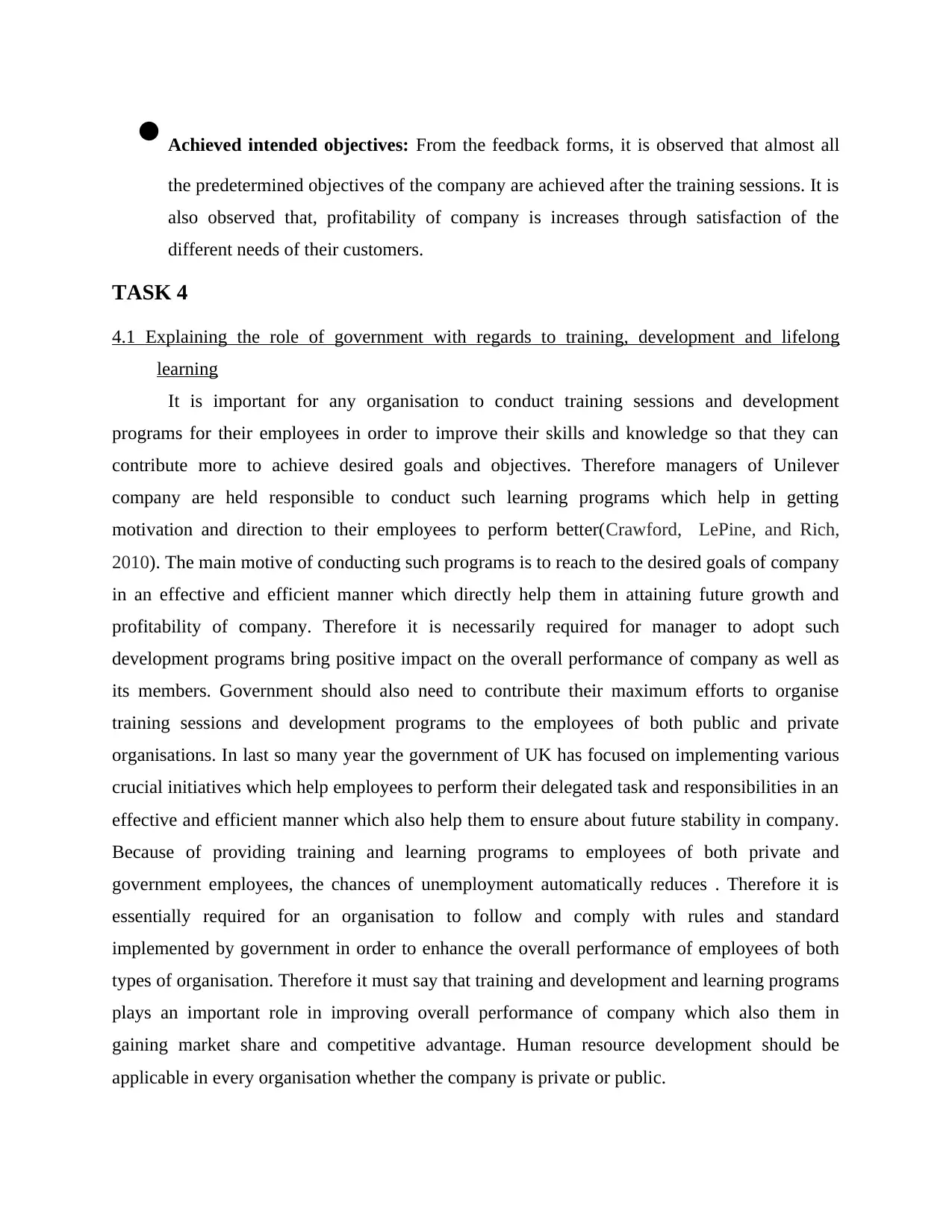
Achieved intended objectives: From the feedback forms, it is observed that almost all
the predetermined objectives of the company are achieved after the training sessions. It is
also observed that, profitability of company is increases through satisfaction of the
different needs of their customers.
TASK 4
4.1 Explaining the role of government with regards to training, development and lifelong
learning
It is important for any organisation to conduct training sessions and development
programs for their employees in order to improve their skills and knowledge so that they can
contribute more to achieve desired goals and objectives. Therefore managers of Unilever
company are held responsible to conduct such learning programs which help in getting
motivation and direction to their employees to perform better(Crawford, LePine, and Rich,
2010). The main motive of conducting such programs is to reach to the desired goals of company
in an effective and efficient manner which directly help them in attaining future growth and
profitability of company. Therefore it is necessarily required for manager to adopt such
development programs bring positive impact on the overall performance of company as well as
its members. Government should also need to contribute their maximum efforts to organise
training sessions and development programs to the employees of both public and private
organisations. In last so many year the government of UK has focused on implementing various
crucial initiatives which help employees to perform their delegated task and responsibilities in an
effective and efficient manner which also help them to ensure about future stability in company.
Because of providing training and learning programs to employees of both private and
government employees, the chances of unemployment automatically reduces . Therefore it is
essentially required for an organisation to follow and comply with rules and standard
implemented by government in order to enhance the overall performance of employees of both
types of organisation. Therefore it must say that training and development and learning programs
plays an important role in improving overall performance of company which also them in
gaining market share and competitive advantage. Human resource development should be
applicable in every organisation whether the company is private or public.
the predetermined objectives of the company are achieved after the training sessions. It is
also observed that, profitability of company is increases through satisfaction of the
different needs of their customers.
TASK 4
4.1 Explaining the role of government with regards to training, development and lifelong
learning
It is important for any organisation to conduct training sessions and development
programs for their employees in order to improve their skills and knowledge so that they can
contribute more to achieve desired goals and objectives. Therefore managers of Unilever
company are held responsible to conduct such learning programs which help in getting
motivation and direction to their employees to perform better(Crawford, LePine, and Rich,
2010). The main motive of conducting such programs is to reach to the desired goals of company
in an effective and efficient manner which directly help them in attaining future growth and
profitability of company. Therefore it is necessarily required for manager to adopt such
development programs bring positive impact on the overall performance of company as well as
its members. Government should also need to contribute their maximum efforts to organise
training sessions and development programs to the employees of both public and private
organisations. In last so many year the government of UK has focused on implementing various
crucial initiatives which help employees to perform their delegated task and responsibilities in an
effective and efficient manner which also help them to ensure about future stability in company.
Because of providing training and learning programs to employees of both private and
government employees, the chances of unemployment automatically reduces . Therefore it is
essentially required for an organisation to follow and comply with rules and standard
implemented by government in order to enhance the overall performance of employees of both
types of organisation. Therefore it must say that training and development and learning programs
plays an important role in improving overall performance of company which also them in
gaining market share and competitive advantage. Human resource development should be
applicable in every organisation whether the company is private or public.
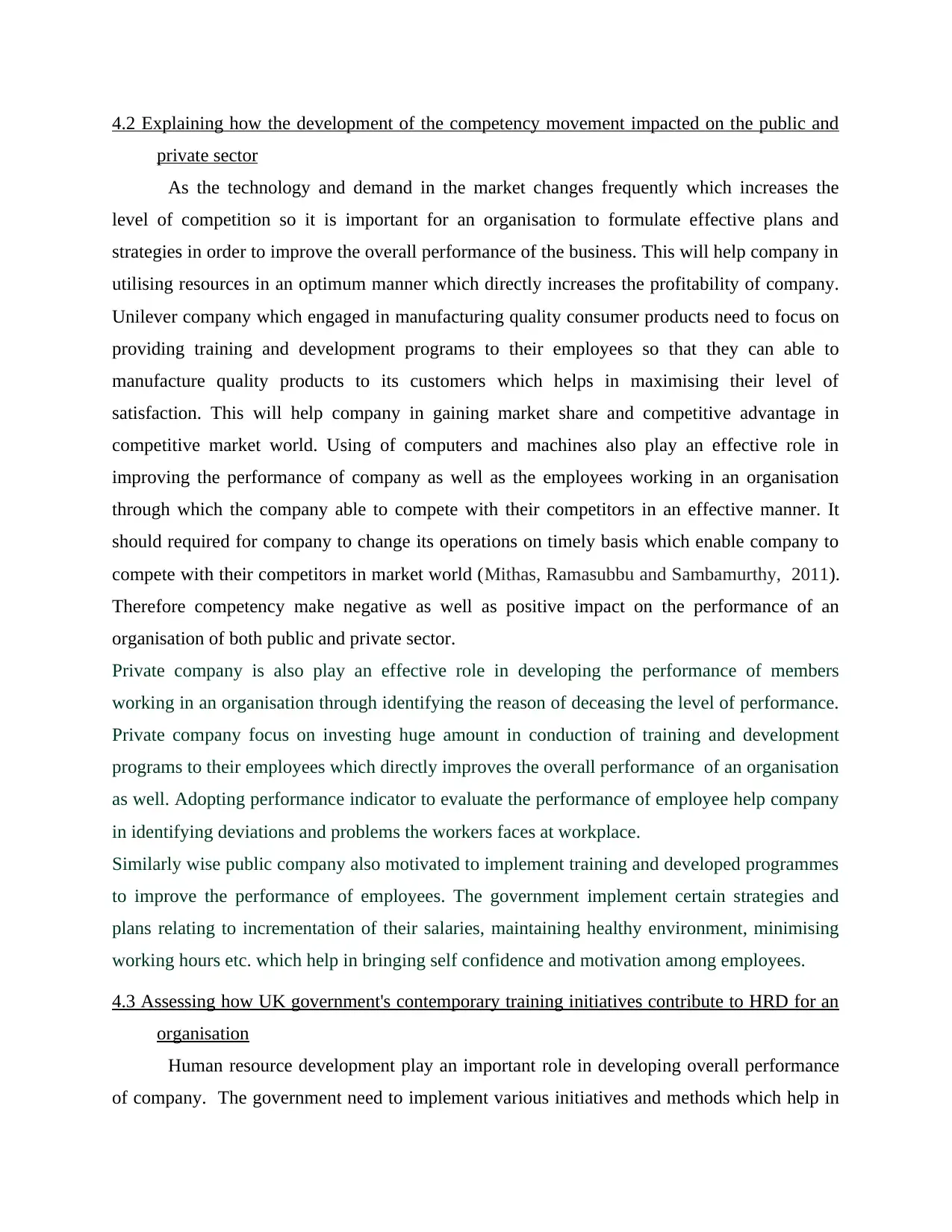
4.2 Explaining how the development of the competency movement impacted on the public and
private sector
As the technology and demand in the market changes frequently which increases the
level of competition so it is important for an organisation to formulate effective plans and
strategies in order to improve the overall performance of the business. This will help company in
utilising resources in an optimum manner which directly increases the profitability of company.
Unilever company which engaged in manufacturing quality consumer products need to focus on
providing training and development programs to their employees so that they can able to
manufacture quality products to its customers which helps in maximising their level of
satisfaction. This will help company in gaining market share and competitive advantage in
competitive market world. Using of computers and machines also play an effective role in
improving the performance of company as well as the employees working in an organisation
through which the company able to compete with their competitors in an effective manner. It
should required for company to change its operations on timely basis which enable company to
compete with their competitors in market world (Mithas, Ramasubbu and Sambamurthy, 2011).
Therefore competency make negative as well as positive impact on the performance of an
organisation of both public and private sector.
Private company is also play an effective role in developing the performance of members
working in an organisation through identifying the reason of deceasing the level of performance.
Private company focus on investing huge amount in conduction of training and development
programs to their employees which directly improves the overall performance of an organisation
as well. Adopting performance indicator to evaluate the performance of employee help company
in identifying deviations and problems the workers faces at workplace.
Similarly wise public company also motivated to implement training and developed programmes
to improve the performance of employees. The government implement certain strategies and
plans relating to incrementation of their salaries, maintaining healthy environment, minimising
working hours etc. which help in bringing self confidence and motivation among employees.
4.3 Assessing how UK government's contemporary training initiatives contribute to HRD for an
organisation
Human resource development play an important role in developing overall performance
of company. The government need to implement various initiatives and methods which help in
private sector
As the technology and demand in the market changes frequently which increases the
level of competition so it is important for an organisation to formulate effective plans and
strategies in order to improve the overall performance of the business. This will help company in
utilising resources in an optimum manner which directly increases the profitability of company.
Unilever company which engaged in manufacturing quality consumer products need to focus on
providing training and development programs to their employees so that they can able to
manufacture quality products to its customers which helps in maximising their level of
satisfaction. This will help company in gaining market share and competitive advantage in
competitive market world. Using of computers and machines also play an effective role in
improving the performance of company as well as the employees working in an organisation
through which the company able to compete with their competitors in an effective manner. It
should required for company to change its operations on timely basis which enable company to
compete with their competitors in market world (Mithas, Ramasubbu and Sambamurthy, 2011).
Therefore competency make negative as well as positive impact on the performance of an
organisation of both public and private sector.
Private company is also play an effective role in developing the performance of members
working in an organisation through identifying the reason of deceasing the level of performance.
Private company focus on investing huge amount in conduction of training and development
programs to their employees which directly improves the overall performance of an organisation
as well. Adopting performance indicator to evaluate the performance of employee help company
in identifying deviations and problems the workers faces at workplace.
Similarly wise public company also motivated to implement training and developed programmes
to improve the performance of employees. The government implement certain strategies and
plans relating to incrementation of their salaries, maintaining healthy environment, minimising
working hours etc. which help in bringing self confidence and motivation among employees.
4.3 Assessing how UK government's contemporary training initiatives contribute to HRD for an
organisation
Human resource development play an important role in developing overall performance
of company. The government need to implement various initiatives and methods which help in
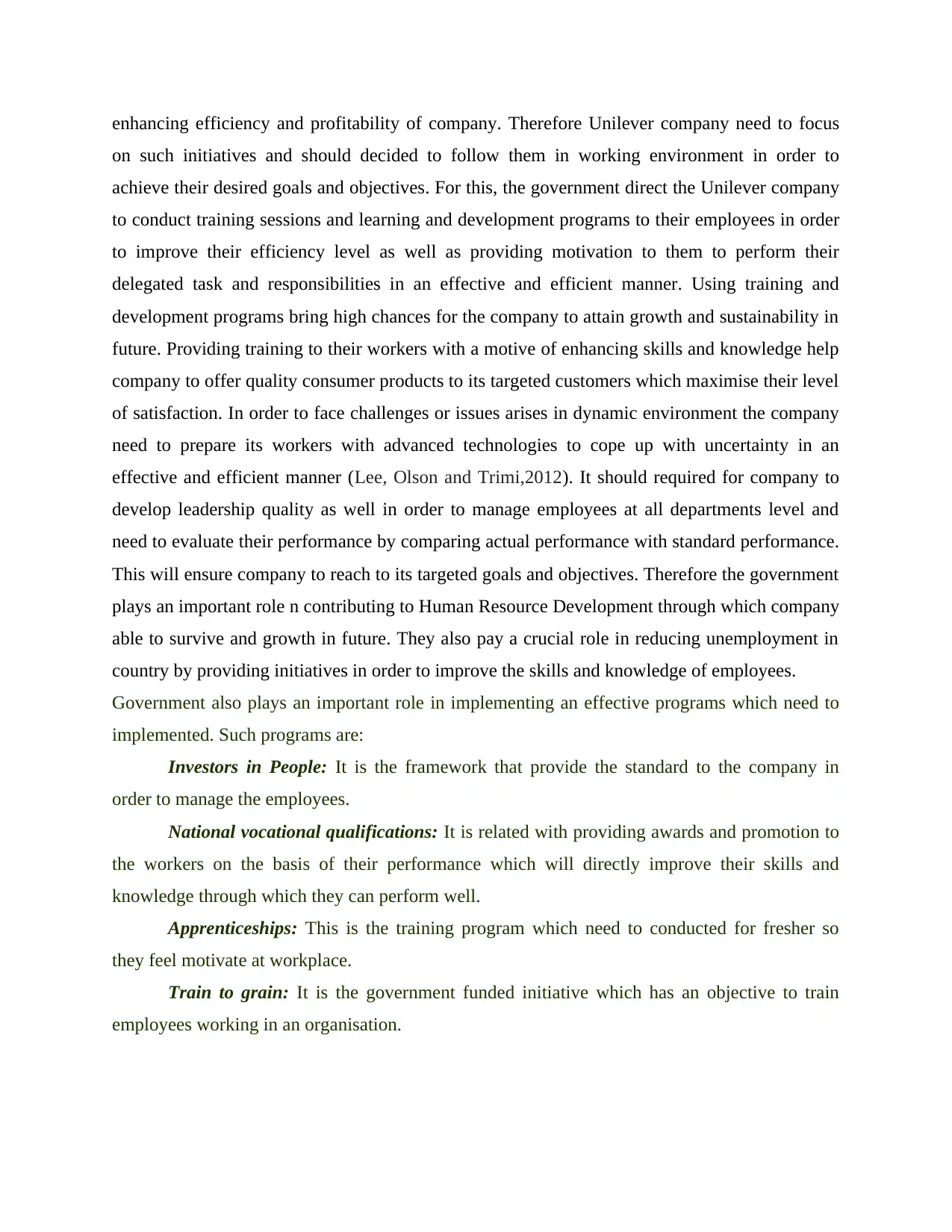
enhancing efficiency and profitability of company. Therefore Unilever company need to focus
on such initiatives and should decided to follow them in working environment in order to
achieve their desired goals and objectives. For this, the government direct the Unilever company
to conduct training sessions and learning and development programs to their employees in order
to improve their efficiency level as well as providing motivation to them to perform their
delegated task and responsibilities in an effective and efficient manner. Using training and
development programs bring high chances for the company to attain growth and sustainability in
future. Providing training to their workers with a motive of enhancing skills and knowledge help
company to offer quality consumer products to its targeted customers which maximise their level
of satisfaction. In order to face challenges or issues arises in dynamic environment the company
need to prepare its workers with advanced technologies to cope up with uncertainty in an
effective and efficient manner (Lee, Olson and Trimi,2012). It should required for company to
develop leadership quality as well in order to manage employees at all departments level and
need to evaluate their performance by comparing actual performance with standard performance.
This will ensure company to reach to its targeted goals and objectives. Therefore the government
plays an important role n contributing to Human Resource Development through which company
able to survive and growth in future. They also pay a crucial role in reducing unemployment in
country by providing initiatives in order to improve the skills and knowledge of employees.
Government also plays an important role in implementing an effective programs which need to
implemented. Such programs are:
Investors in People: It is the framework that provide the standard to the company in
order to manage the employees.
National vocational qualifications: It is related with providing awards and promotion to
the workers on the basis of their performance which will directly improve their skills and
knowledge through which they can perform well.
Apprenticeships: This is the training program which need to conducted for fresher so
they feel motivate at workplace.
Train to grain: It is the government funded initiative which has an objective to train
employees working in an organisation.
on such initiatives and should decided to follow them in working environment in order to
achieve their desired goals and objectives. For this, the government direct the Unilever company
to conduct training sessions and learning and development programs to their employees in order
to improve their efficiency level as well as providing motivation to them to perform their
delegated task and responsibilities in an effective and efficient manner. Using training and
development programs bring high chances for the company to attain growth and sustainability in
future. Providing training to their workers with a motive of enhancing skills and knowledge help
company to offer quality consumer products to its targeted customers which maximise their level
of satisfaction. In order to face challenges or issues arises in dynamic environment the company
need to prepare its workers with advanced technologies to cope up with uncertainty in an
effective and efficient manner (Lee, Olson and Trimi,2012). It should required for company to
develop leadership quality as well in order to manage employees at all departments level and
need to evaluate their performance by comparing actual performance with standard performance.
This will ensure company to reach to its targeted goals and objectives. Therefore the government
plays an important role n contributing to Human Resource Development through which company
able to survive and growth in future. They also pay a crucial role in reducing unemployment in
country by providing initiatives in order to improve the skills and knowledge of employees.
Government also plays an important role in implementing an effective programs which need to
implemented. Such programs are:
Investors in People: It is the framework that provide the standard to the company in
order to manage the employees.
National vocational qualifications: It is related with providing awards and promotion to
the workers on the basis of their performance which will directly improve their skills and
knowledge through which they can perform well.
Apprenticeships: This is the training program which need to conducted for fresher so
they feel motivate at workplace.
Train to grain: It is the government funded initiative which has an objective to train
employees working in an organisation.
Secure Best Marks with AI Grader
Need help grading? Try our AI Grader for instant feedback on your assignments.
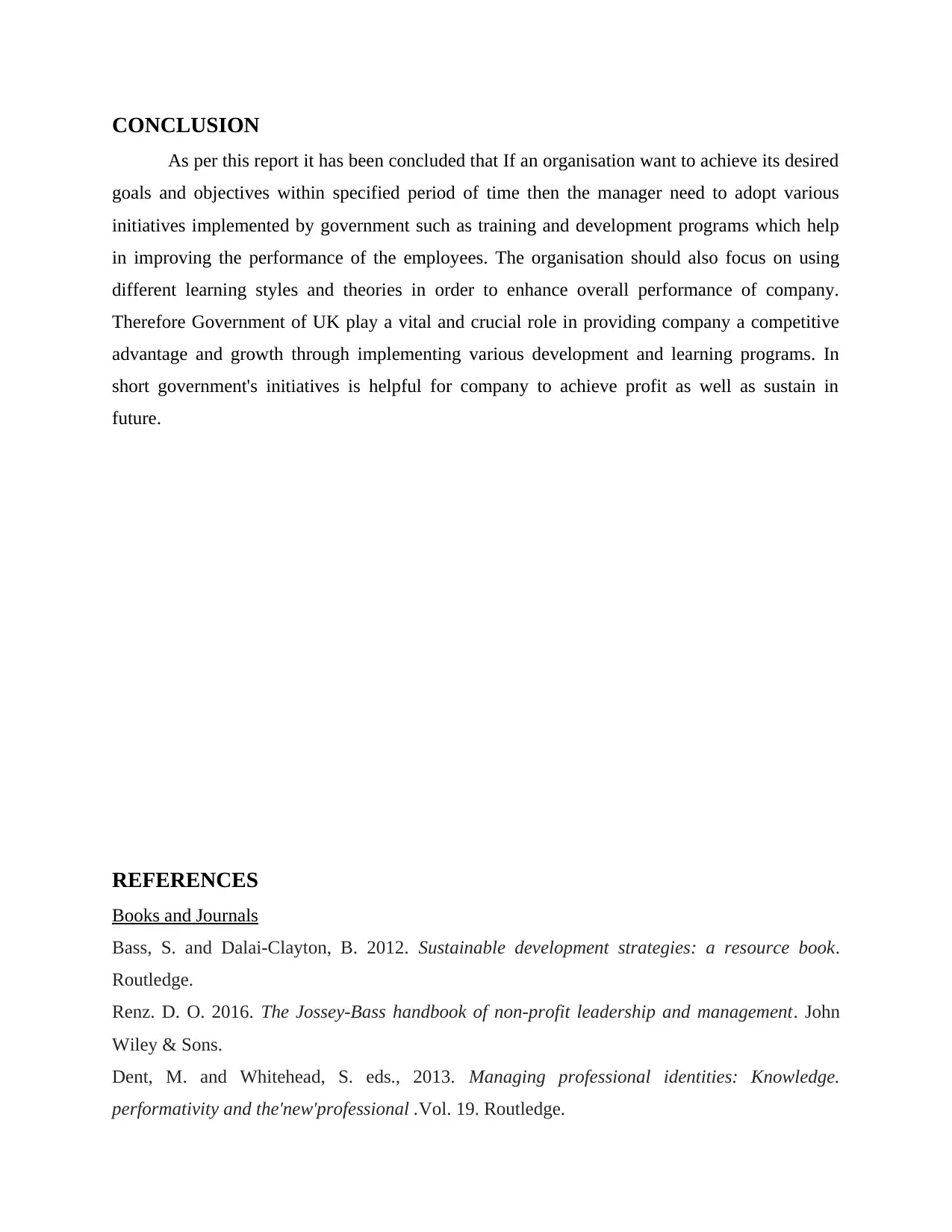
CONCLUSION
As per this report it has been concluded that If an organisation want to achieve its desired
goals and objectives within specified period of time then the manager need to adopt various
initiatives implemented by government such as training and development programs which help
in improving the performance of the employees. The organisation should also focus on using
different learning styles and theories in order to enhance overall performance of company.
Therefore Government of UK play a vital and crucial role in providing company a competitive
advantage and growth through implementing various development and learning programs. In
short government's initiatives is helpful for company to achieve profit as well as sustain in
future.
REFERENCES
Books and Journals
Bass, S. and Dalai-Clayton, B. 2012. Sustainable development strategies: a resource book.
Routledge.
Renz. D. O. 2016. The Jossey-Bass handbook of non-profit leadership and management. John
Wiley & Sons.
Dent, M. and Whitehead, S. eds., 2013. Managing professional identities: Knowledge.
performativity and the'new'professional .Vol. 19. Routledge.
As per this report it has been concluded that If an organisation want to achieve its desired
goals and objectives within specified period of time then the manager need to adopt various
initiatives implemented by government such as training and development programs which help
in improving the performance of the employees. The organisation should also focus on using
different learning styles and theories in order to enhance overall performance of company.
Therefore Government of UK play a vital and crucial role in providing company a competitive
advantage and growth through implementing various development and learning programs. In
short government's initiatives is helpful for company to achieve profit as well as sustain in
future.
REFERENCES
Books and Journals
Bass, S. and Dalai-Clayton, B. 2012. Sustainable development strategies: a resource book.
Routledge.
Renz. D. O. 2016. The Jossey-Bass handbook of non-profit leadership and management. John
Wiley & Sons.
Dent, M. and Whitehead, S. eds., 2013. Managing professional identities: Knowledge.
performativity and the'new'professional .Vol. 19. Routledge.
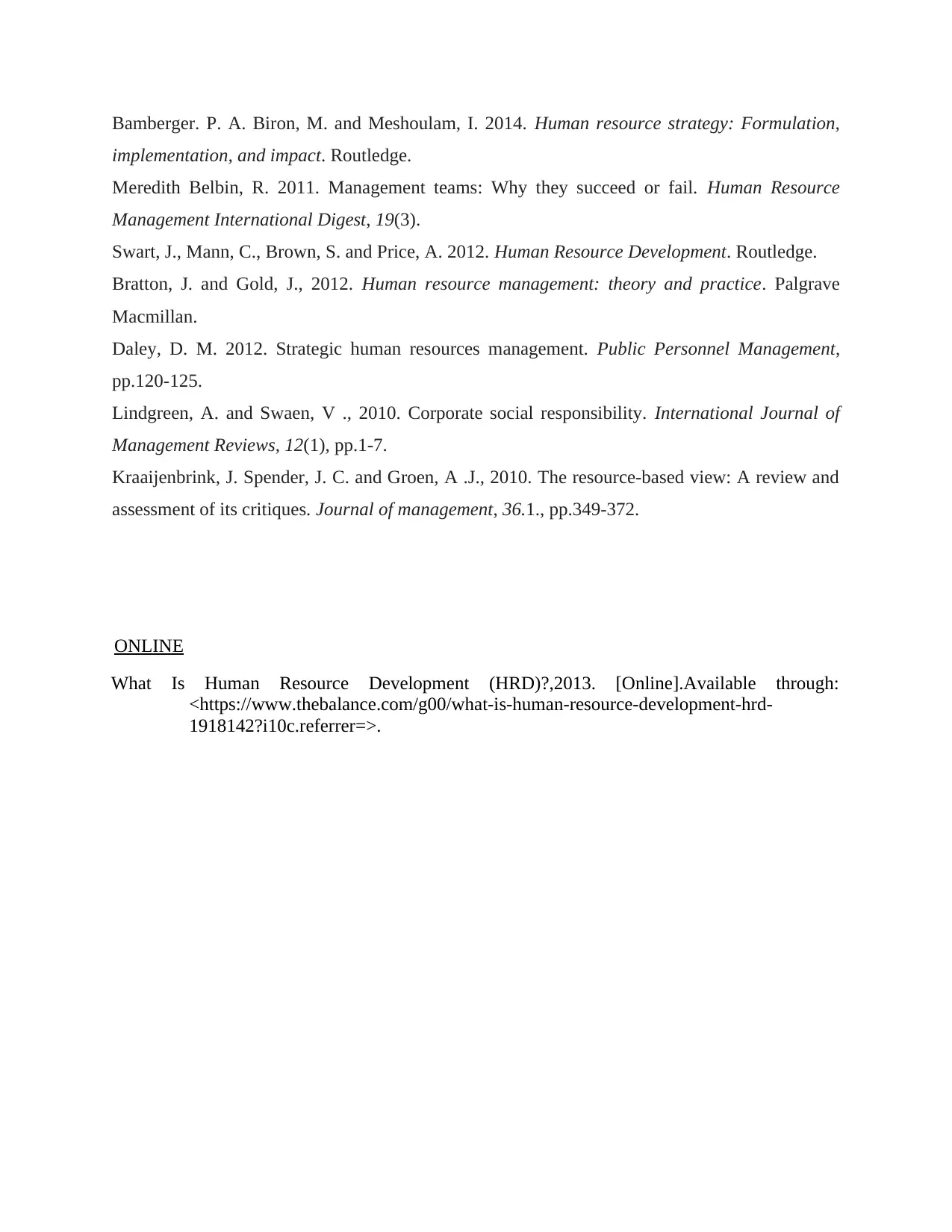
Bamberger. P. A. Biron, M. and Meshoulam, I. 2014. Human resource strategy: Formulation,
implementation, and impact. Routledge.
Meredith Belbin, R. 2011. Management teams: Why they succeed or fail. Human Resource
Management International Digest, 19(3).
Swart, J., Mann, C., Brown, S. and Price, A. 2012. Human Resource Development. Routledge.
Bratton, J. and Gold, J., 2012. Human resource management: theory and practice. Palgrave
Macmillan.
Daley, D. M. 2012. Strategic human resources management. Public Personnel Management,
pp.120-125.
Lindgreen, A. and Swaen, V ., 2010. Corporate social responsibility. International Journal of
Management Reviews, 12(1), pp.1-7.
Kraaijenbrink, J. Spender, J. C. and Groen, A .J., 2010. The resource-based view: A review and
assessment of its critiques. Journal of management, 36.1., pp.349-372.
ONLINE
What Is Human Resource Development (HRD)?,2013. [Online].Available through:
<https://www.thebalance.com/g00/what-is-human-resource-development-hrd-
1918142?i10c.referrer=>.
implementation, and impact. Routledge.
Meredith Belbin, R. 2011. Management teams: Why they succeed or fail. Human Resource
Management International Digest, 19(3).
Swart, J., Mann, C., Brown, S. and Price, A. 2012. Human Resource Development. Routledge.
Bratton, J. and Gold, J., 2012. Human resource management: theory and practice. Palgrave
Macmillan.
Daley, D. M. 2012. Strategic human resources management. Public Personnel Management,
pp.120-125.
Lindgreen, A. and Swaen, V ., 2010. Corporate social responsibility. International Journal of
Management Reviews, 12(1), pp.1-7.
Kraaijenbrink, J. Spender, J. C. and Groen, A .J., 2010. The resource-based view: A review and
assessment of its critiques. Journal of management, 36.1., pp.349-372.
ONLINE
What Is Human Resource Development (HRD)?,2013. [Online].Available through:
<https://www.thebalance.com/g00/what-is-human-resource-development-hrd-
1918142?i10c.referrer=>.
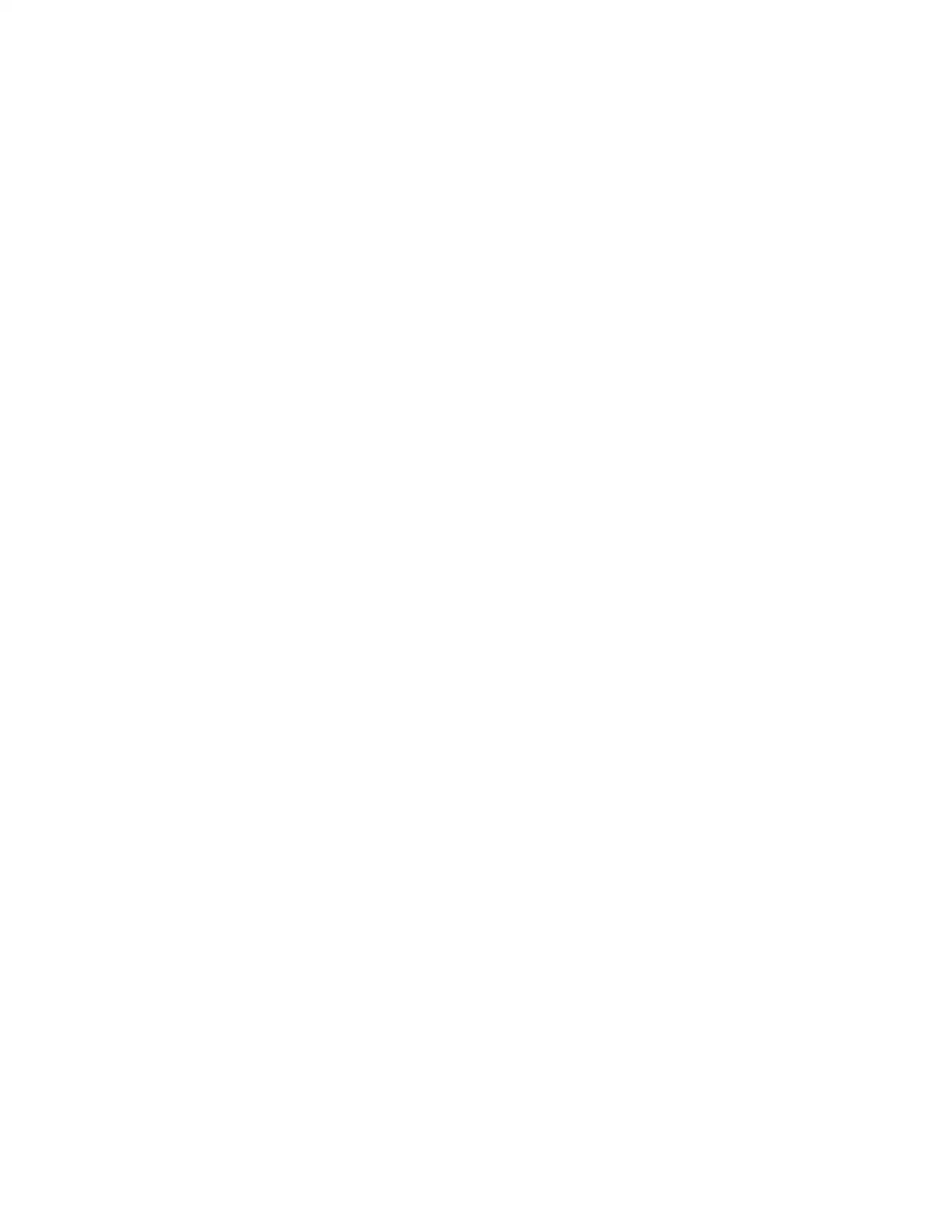
Paraphrase This Document
Need a fresh take? Get an instant paraphrase of this document with our AI Paraphraser
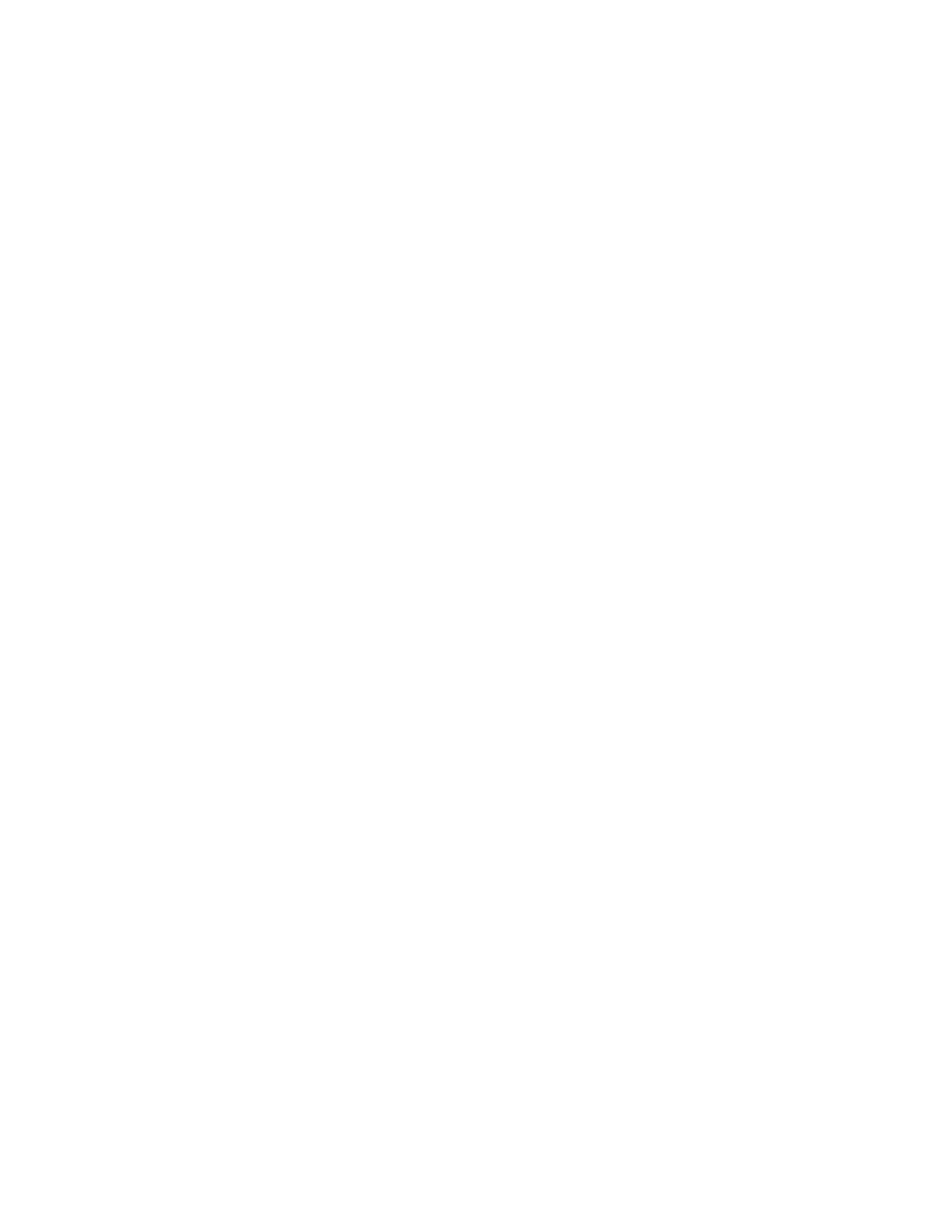
1 out of 20
Related Documents
Your All-in-One AI-Powered Toolkit for Academic Success.
+13062052269
info@desklib.com
Available 24*7 on WhatsApp / Email
![[object Object]](/_next/static/media/star-bottom.7253800d.svg)
Unlock your academic potential
© 2024 | Zucol Services PVT LTD | All rights reserved.





